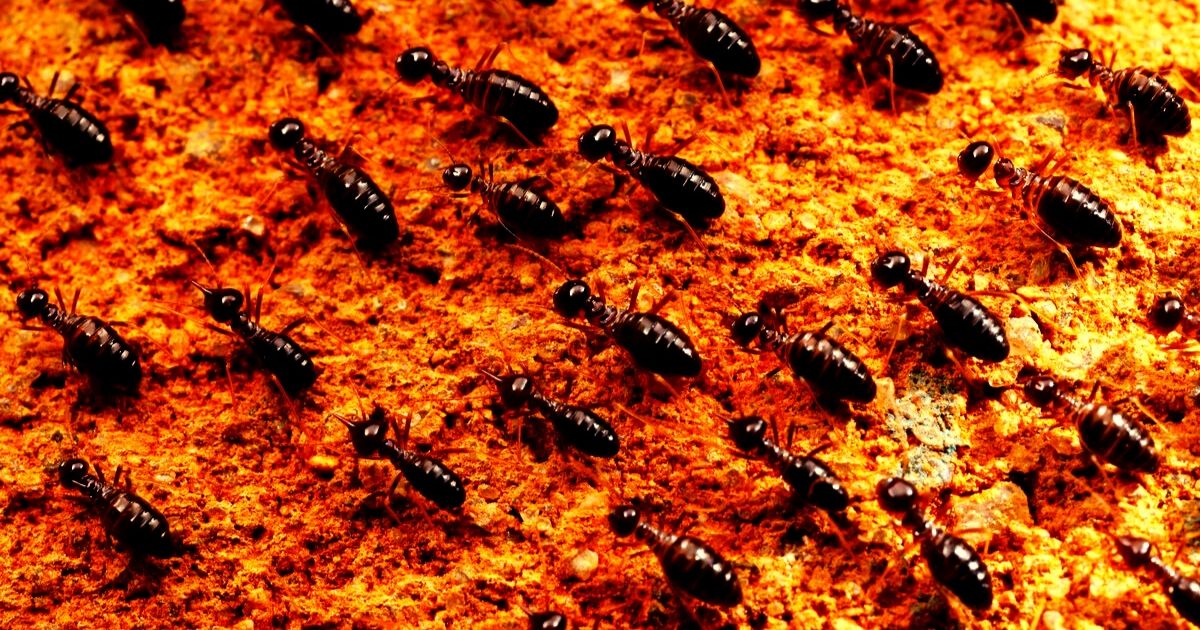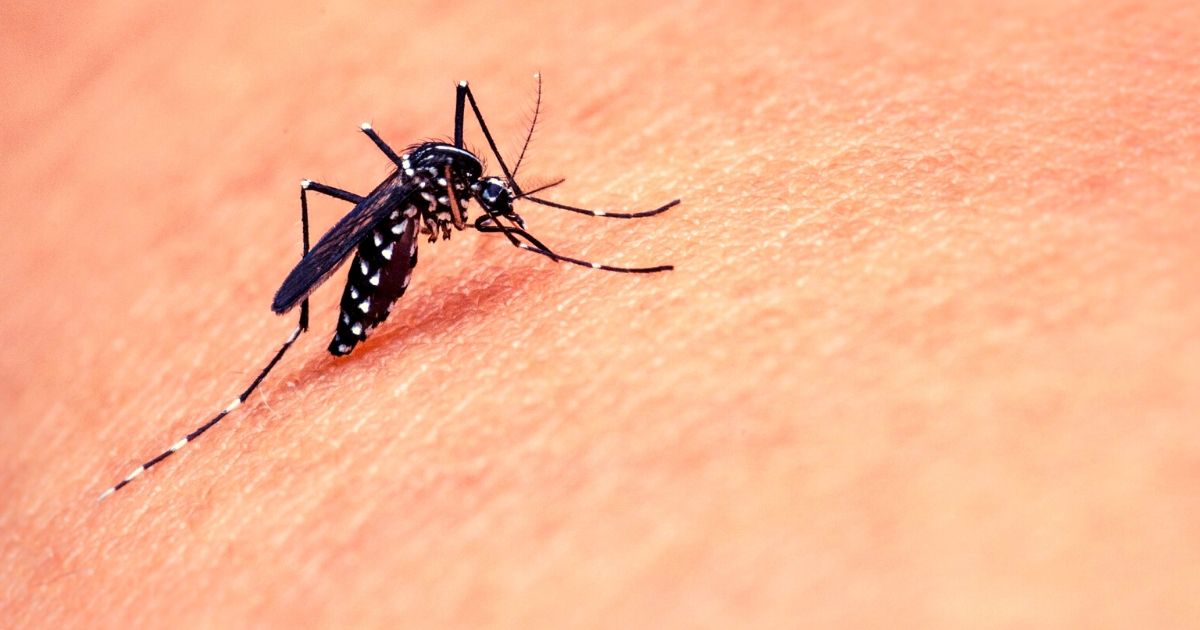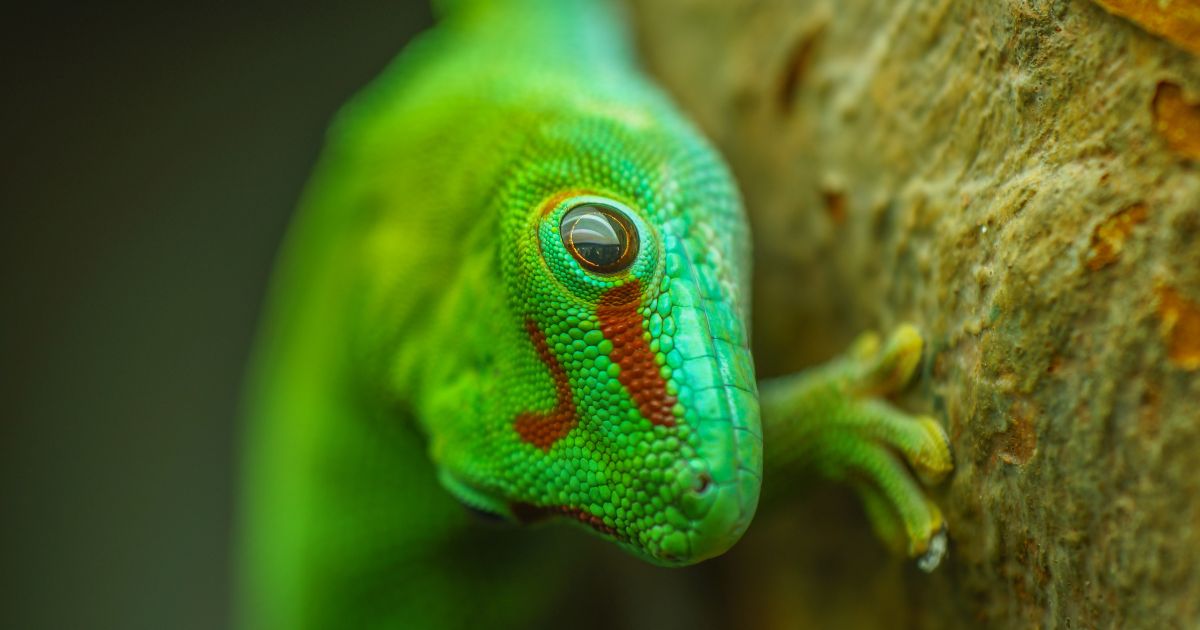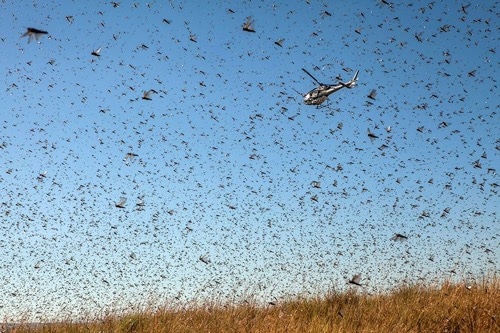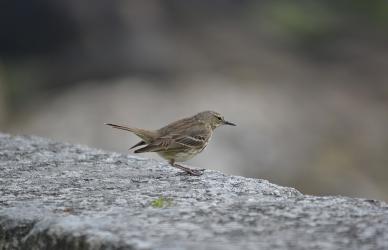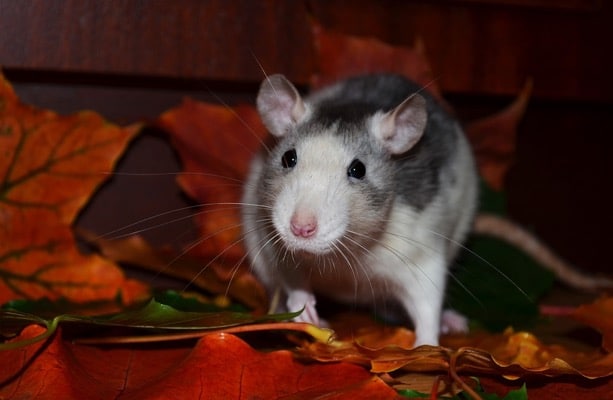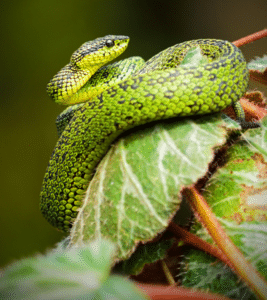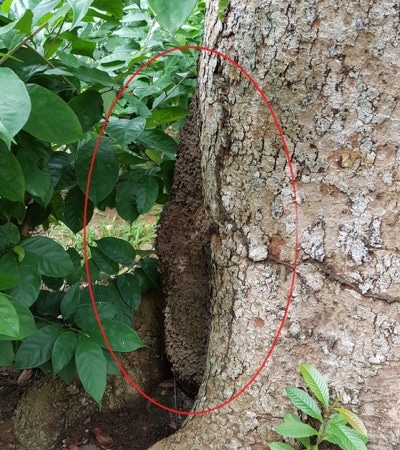The Complete Guide to Mouse and Rat Traps: How Do They Work
Rodents

Having rats or mice in your home poses health risks to you and your family and can cause damage to your property. When it comes to dealing with rodents, mouse and rat traps are an effective solution. Let’s explore the benefits of using traps, how they work, and how to successfully catch mice and rats with commercial and DIY traps.
Benefits of Rat and Mouse Traps
The benefits of rat and mouse traps extend beyond convenience, as this is a safe and effective method to get rid of rodents in your home. Some of the key benefits include:
- Efficiency: Mouse and rat traps are highly effective in capturing rodents, providing a quick solution to infestations.
- Safety: Unlike some chemical methods, traps pose minimal risks to humans, pets, and the environment. They can be used in spaces where chemical solutions are not allowed.
- Cost-Effective: Traps are generally affordable and reusable, making them a budget-friendly option for rodent control.
Want to find out more about rodent control in Singapore?
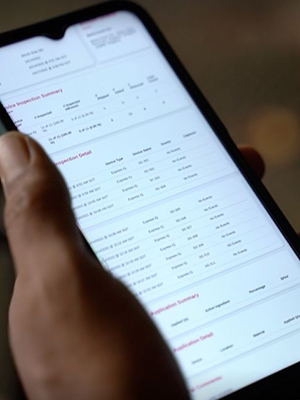
How Do Rodent Traps Work
Rat and mouse traps use the principle of attracting the rodent with bait and triggering a mechanism to capture or kill the intruder. There are different types of traps, including snap traps, electronic traps, glue traps, and live traps.
- Snap Traps: These traditional traps use a spring-loaded mechanism, attracting rodents with food or nesting material. They are placed along rodent pathways and snap shut when the rodent takes the bait.
- Electronic Traps: These traps deliver a high-voltage shock when the rodent enters the trap.
- Glue Traps: Rodents get stuck to the adhesive surface of these traps, allowing for easy disposal.
- Live Traps: Designed for homeowners who want to catch mice or rats alive, these traps allow for relocation without harming them. They attract rodents with food and capture them inside the trap. After that, homeowners need to release rodents away from the property, so that rodents don’t find their way inside again.
Do Mouse Traps Work on Rats?
For a lot of people all rodents look similar, but due to the differences between rats and mice you need to adjust the extermination methods. While mouse traps can catch smaller rodents, they may not be effective for larger rats. It’s important to choose traps that are appropriately sized for the target species. Rat traps are larger and more powerful, ensuring successful capture.
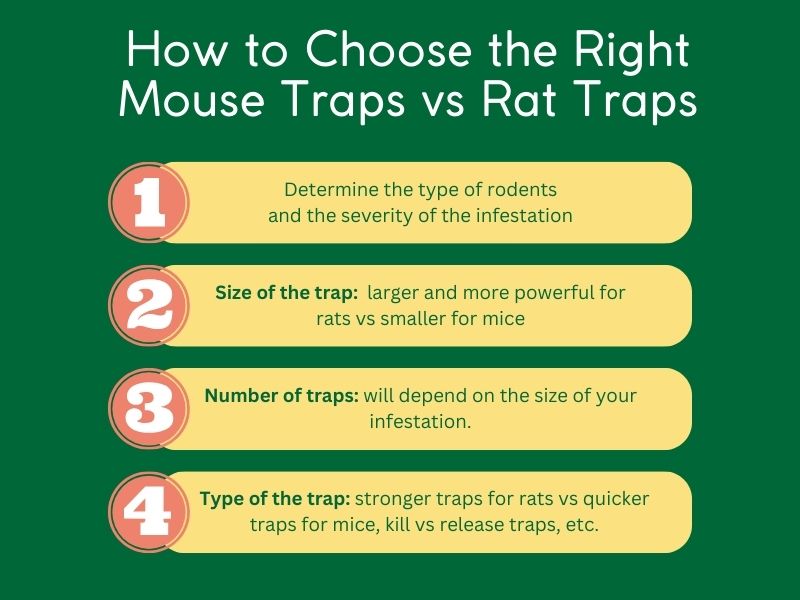
Choosing the Right Mouse Traps vs Rat Traps
When selecting rodent traps, start by determining the type of rodent and the severity of the infestation. Some other factors to consider when choosing the mouse or rat traps include:
- Size of the trap – rat traps are typically larger and more powerful, while mouse traps are designed for smaller rodents.
- Number of traps – will depend on the size of your infestation.
- Type of trap – rats usually require stronger traps, while mouse traps need to capture mice quickly (e.g. using glue or snap traps). Consider if you want to kill rodents or release them after capturing, and choose traps with sensitivity adjustments for different rodent sizes.
DIY Rodent Traps
For those who prefer a do-it-yourself approach, there are several DIY mouse and rat traps that can be crafted using common household items. Examples include bucket traps, bottle traps, and paper tube traps. While these may not be as effective as commercial traps, they can provide a temporary solution in a pinch.
Where to Place Rat and Mouse Traps
For rodent traps to work, it is essential to place them in the right place. To get better results, follow these tips when placing the rat and mouse traps:
- Identify activity areas: Place traps where you notice signs of rodent activity, such as droppings, gnaw marks, or nesting sites.
- Along walls and baseboards: Rodents often travel along walls, so placing traps along their usual pathways increases the chances of success.
- In dark corners and crevices: Rodents prefer dark and hidden areas, making these ideal locations for trap placement.
Pro Tip: If you have a large rodent infestation, it might be necessary to consult with pest control experts.
Tips to Catch Rodents Successfully
Here are some additional tips on how to trap mice and rats successfully:
- Use the right bait that is attractive to rodents, such as peanut butter, chocolate, or seeds. Change the bait after several days if it doesn’t work.
- Check traps frequently, remove captured rodents promptly and reset traps to maintain effectiveness.
- Regularly move traps to different locations (once in 2-3 days) to increase the chances of capturing rodents.
- Increase your chances of success by using several traps simultaneously, especially in areas with high rodent activity. Install multiple traps in rodents’ “favourite” places.
- Be patient and persistent: rodent control may require time and multiple attempts. Adjust your strategy based on the effectiveness of your traps.
- Use other rodent prevention methods: ensure sanitation and proper food storage, remove debris and food spills, and seal the potential entry points.

Pest Problem? Let Us Help.
We offer fast and effective precision treatments to eliminate pests while ensuring a safe environment for your home or business.
Smart Rodent Control Strategy
Rat and mouse traps are effective tools against rodents, and placing them strategically can help successfully manage rodent infestations. In case of larger rodent infestations, it is worth consulting with pest control experts. They can handle rodent baits and traps professionally, and can also help you develop and implement an effective rodent monitoring strategy to prevent future infestations.
Author: Soleha Nisaa
Frequently Asked Questions
The best baits for mouse and rat traps are peanut butter, chocolate, nuts, seeds, dried fruit, and bacon. Experimenting with different baits can help determine what works best in your specific situation.
Check traps frequently, ideally every 12-24 hours, to ensure captured rodents are promptly removed and to prevent odor and contamination.
While mouse and rat traps are generally safe when used correctly, some traps can potentially cause injury if mishandled. Glue traps can also pose risks if children or pets get into contact with them.
Related Posts
What Repels Rodents? Sounds, Smells & Other Remedies
Rodents

Rodents have long been unwelcome guests in our homes, gardens, and even cars. Their ability to cause property damage and spread diseases has raised the need to develop various methods to repel them. From the high-tech electronic solutions to the natural remedies, the variety of effective repellents continues to grow. Let’s explore if they truly work, and if so, how can you use them most effectively?
How to Repel Rodents?
To get rid of rodents, it’s best to use multiple methods that target different aspects of rodent behavior. Here are some effective strategies to consider:
Seal Entry Points. Rodents can squeeze through tiny openings. Inspect your home, car, or other areas for gaps or cracks and seal them properly.
Maintain Cleanliness. Rodents are attracted to food and shelter. Keep your surroundings clean and properly store food to avoid attracting rodents.
Natural Predators. If possible, introduce natural predators of rodents, such as cats or certain breeds of dogs, to the area.
Traps. Traditional traps can be effective in reducing rodent populations.
Scent Repellents. Rodents have sensitive noses and avoid certain smells. Consider using natural scents like peppermint oil, garlic, or ammonia to deter them.
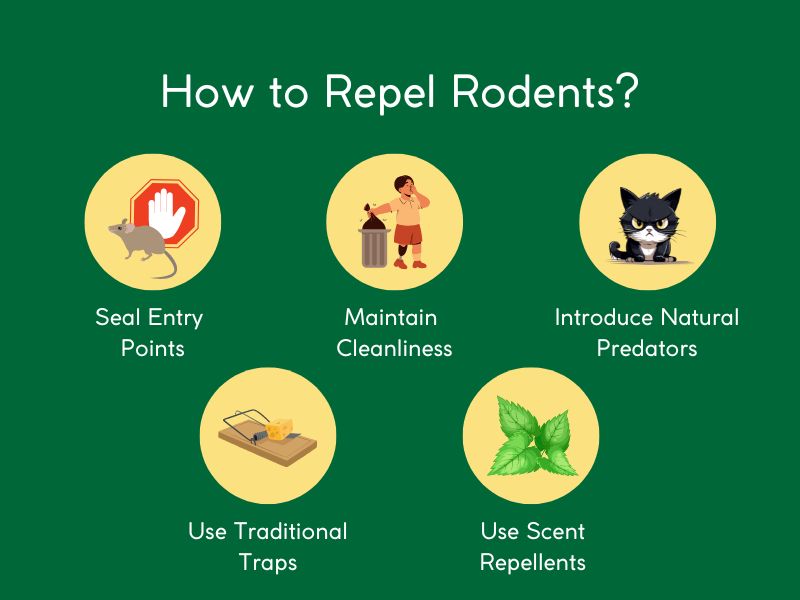
Do Electronic Rodent Repellents Work?
Electronic rodent repellents, often referred to as sonic or ultrasonic devices, are popular solutions for repelling rodents. These devices create a high-frequency sound that is uncomfortable for rodents, thus driving them away.
While some studies suggest that electronic rodent repellents are effective to some point, their success depends on factors such as the specific frequency of the sound waves, the layout of the area, and the type of rodents present. Some rodents might get used to the sound over time, making the electronic devices less effective.
Therefore, while electronic rodent repellents can be a part of your rodent prevention strategy, they might not provide a foolproof solution on their own.
Want to find out more about 24/7 rodent monitoring in Singapore?

How 24/7 Rodent Monitoring Helps to Repel Rodents?
24/7 rodent monitoring is an innovative technology and an essential component of modern pest control strategy aimed to prevent rodent infestations. 24/7 rodent monitoring devices allow early detection of rodent presence, which enables solving rodent issues fast and effectively. This advanced system combines motion-activated cameras, sensor networks, and artificial intelligence algorithms, to continuously track and analyze rodent activity in various environments.
24/7 rodent monitoring is a safer and more sustainable solution for pest management, and adding it to your pest control strategy allows to minimize the use of harmful chemicals and ensures.
Pro Tip: Combining various approaches is essential for creating an efficient strategy to control rodents.
How to Repel Rodents from Your Car
Rodents can also infest vehicles, causing damage to wiring and other components. Here are some tips that can help you repel rodents from your car:
Keep the Car Locked. Rodents are often attracted to the warm engine compartments and can seek shelter in cars. Keep your vehicle closed when it’s parked to make the area less inviting.
Use Rodent-Repelling Sachets. Place sachets of strong-smelling substances like peppermint, mothballs, or cedarwood in the car’s interior and engine area.
Regular Cleaning. Clean your car regularly to remove any food crumbs, garbage or potential nesting materials.
Do Natural Rodent Repellents Work?
Natural rodent repellents are often used as an alternative to chemical solutions. Some scents are believed to repel rodents due to their strong odor. While these natural remedies might not be as effective as chemical products, many people get positive results when using them with other preventive measures.
What Smells Drive Rodents Away?
Certain smells are known to be particularly offensive to rodents, including:
- Peppermint: The strong scent of peppermint oil is known to deter rodents.
- Garlic: Rodents dislike the powerful aroma of garlic, making it a potential repellent.
- Predator Urine: The scent of predators, such as cats or foxes, can signal danger to rodents.

Pest Problem? Let Us Help.
We offer fast and effective precision treatments to eliminate pests while ensuring a safe environment for your home or business.
Keeping Rodents Away
Repelling rodents requires a combination of various methods, including electronic and sonic devices, natural remedies and scent repellent. By adopting a comprehensive rodent repellent plan, you can better safeguard your living spaces and belongings from these unwanted intruders.
Author: Soleha Nisaa
Frequently Asked Questions
To remove rodents from gardens or outdoor spaces, consider using natural repellents like garlic spray, planting rodent-repelling plants such as marigolds, or using motion-activated sprinklers to startle and discourage them.
Rodents have different preferences, so there isn’t a one-size-fits-all solution. It’s often best to use a combination of methods, including traps, natural repellents, and proper sanitation practices, to effectively repel rodents.
If you have a severe or persistent rodent infestation, it’s best to consult a professional pest control service like Killem Pest. We have the expertise and tools to effectively address the issue.
Related Posts
Remote Rodent Monitoring System: A Guide to What, Why & How
Rodents
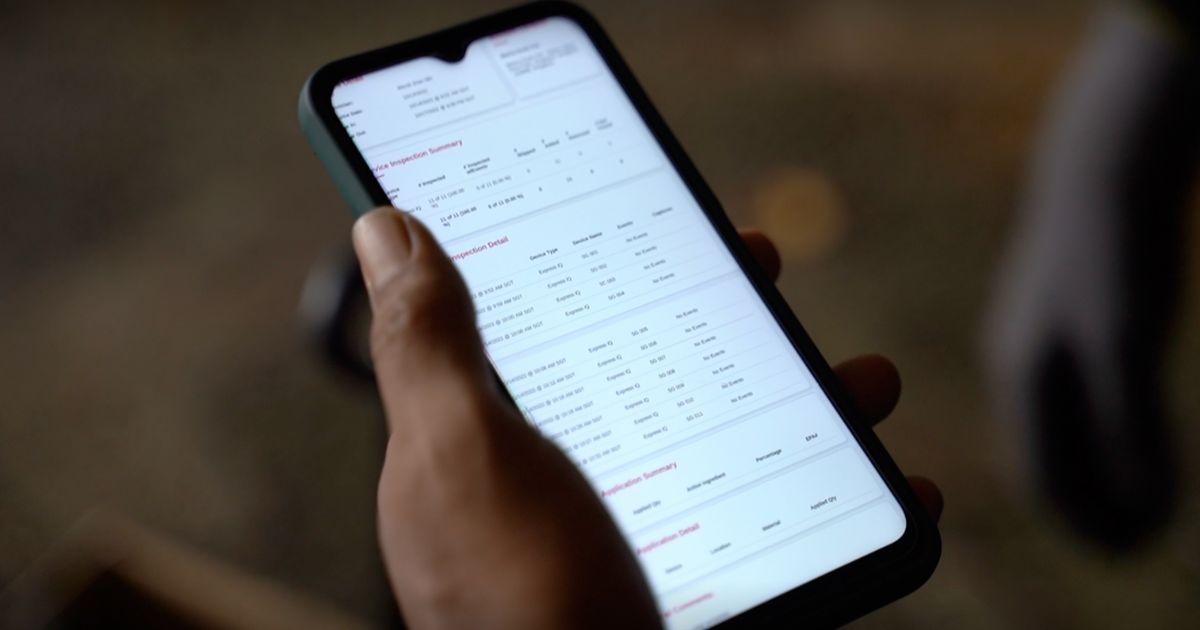
As technology continues to transform various industries, pest control is no exception. Traditional pest control methods often involve time-consuming and labor-intensive approaches. However, the rise of new tech solutions like remote rodent monitoring has offered pest professionals a more effective way to manage these unwanted invaders.
What is Remote Rodent Monitoring?
Remote rodent monitoring is a modern technology that allows individuals and businesses to detect and track rodent activity in real-time. These monitoring systems consist of sensors, data analysis and communication methods that notify users about the potential infestations. Using remote rodent monitoring for pest control offers some advantages compared to traditional solutions.
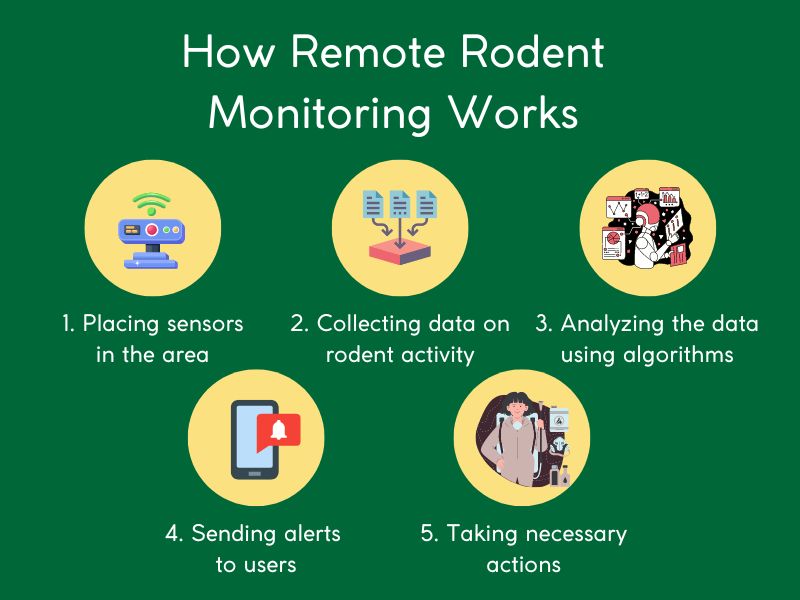
How the Remote Rodent Sensing Technology Works
The remote rodent monitoring process involves several steps:
- Placing sensors throughout the monitored area. One can place sensors in walls, floors, or ceilings, and they can detect rodent movements, sounds or heat signatures.
- Collecting data on rodent activity. Once sensors are set up, they start to collect the data and send it to the servers for real-time analysis.
- Analyzing the data using advanced rodent monitoring algorithms. The systems can determine the location, frequency and severity of rodent activity. They can also distinguish the rodent activity signals from other factors like wind or vibration.
- Alerting users about rodent activity. If rodent activity is being detected, the system automatically generates alerts and sends them via email or text message to the users. The system also generates reports that users can check through web-based solutions or mobile app. This proactive approach allows users to take necessary actions and prevent severe infestations.
- Taking necessary actions. Once users get alerted about rodent activity, they can take immediate actions to address the problem. This may include setting traps, sealing entry points, or hiring a pest control professional to address the issue.

Advantages of Remote Rodent Monitoring Over Traditional Pest Control
Remote rodent monitoring has several advantages over traditional pest control methods. Some of the benefits include:
- Early detection and intervention: Remote rodent monitoring systems allow users to detect infestation early and take action before infestation becomes severe. This, in return, prevents costly property damage and repairs.
- Non-Toxic: Remote rodent monitoring is a safer alternative to traditional pest control methods, as it doesn’t require use of toxic chemicals and pesticides. This means reduced health risks for people and less environment
- Cost-Effective: Rodent monitoring systems can be more cost-effective than traditional pest control methods. Besides reducing costly damage, they allow to detect the first signs of the infestation, thus requiring less manpower to deal with the infestation.
- Data-Driven: Remote rodent monitoring systems use advanced algorithms to analyze data about rodent activity. This allows users to take targeted action to prevent infestations in specific areas.
- Proactive: While traditional pest control methods are reactive (applied once the infestation is discovered), remote monitoring systems allow to take quick proactive measures before the infestation is in place.
Remote Rodent Monitoring Limitations
Even though remote rodent monitoring systems are an innovative solution for detecting and preventing rodent infestations, they do have limitations. Here are some of the main limitations:
- Remote rodent monitoring systems can generate false positive They can be caused by environmental factors or non-rodent species that can trigger sensors, and can lead to unnecessary alarms and costs.
- The range of remote rodent monitoring systems have limited detection range. This can be caused by the placement and sensitivity of the sensors. For complex areas one might need to install multiple sensors to get the full coverage of the area.
- Remote rodent monitoring systems can detect only a limited range of rodent infestations signs. Some specific signs like droppings, tail swipes, footprints, smells, simply cannot be detected by sensors.
- Remote rodent monitoring systems do not provide measures for removing rodents, they can only help to detect and prevent infestations. To remove the rodent infestation, you will still need to use traditional pest control methods, such as trapping or baiting.
- Remote rodent monitoring systems can be costly to install and maintain. The cost of the system depends on the size of the monitored area and the complexity of the installation.
- Remote rodent monitoring systems depend on technology, which can break and show
Pro Tip: For best results, combine remote rodent monitoring with traditional pest control methods.
Combining Remote Rodent Monitoring with Traditional Pest Control Methods
Rodent control services have changed dramatically over the years. However, automated monitoring systems won’t be able to replace pest control experts and traditional methods. Combining them with traditional pest control methods is the best way to provide comprehensive coverage against rodent infestations.
If you are looking for a comprehensive solution, don’t hesitate to reach out to Killem Pest. We provide clients with a complete rodent control package that includes rodent monitoring devices installed strategically, as well as traditional pest control methods.

Pest Problem? Let Us Help.
We offer fast and effective precision treatments to eliminate pests while ensuring a safe environment for your home or business.
Author: Soleha Nisaa
Frequently Asked Questions
Yes, remote rodent monitoring can be used in various areas, including residential homes, commercial buildings, food processing facilities, and agricultural environments.
Yes, remote monitoring can help prevent rodent infestations from causing property damage, contamination, and health risks associated with rodent-borne diseases.
Yes, some remote rodent monitoring systems can distinguish between different types of rodents based on their size, movement patterns, or other characteristics. This information can be then used to customize the rodent control strategy.
Yes, remote rodent monitoring systems can be used both indoor and outdoor environment like gardens, agricultural fields, and industrial sites. Outdoor systems can withstand environmental conditions and can provide insights into rodent behavior in open spaces.
Related Posts
The Complete Guide to Rodent Prevention, Treatment and Control in Singapore
Rodents
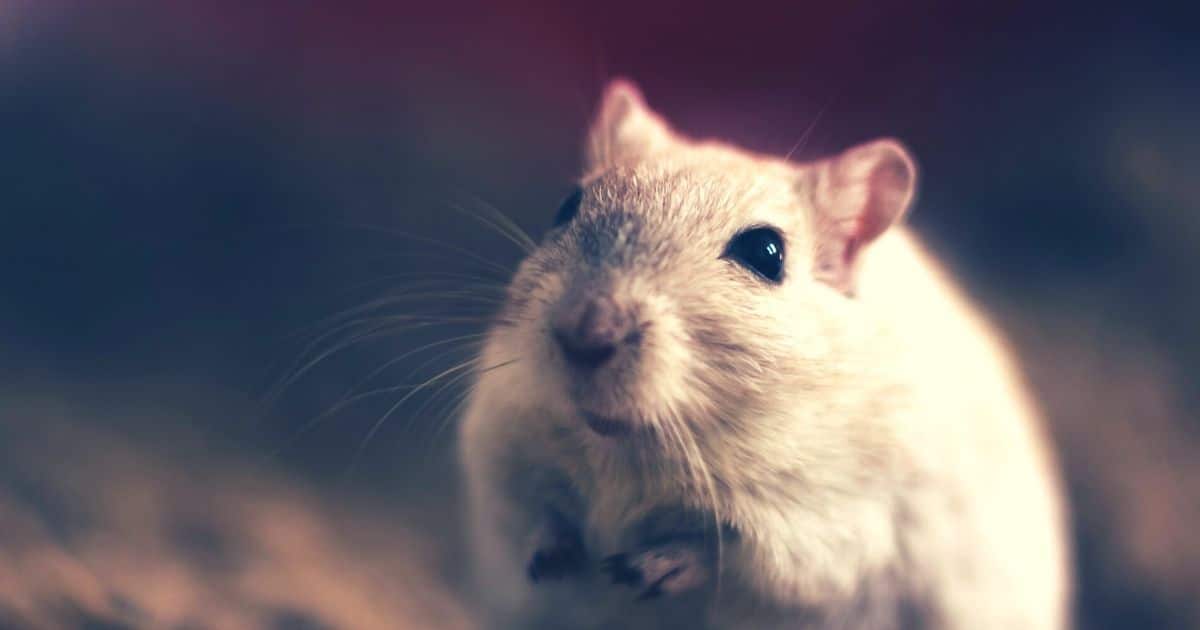
Rodents are mammals with a high degree of intelligence. Rodents belong to the family Rodentia which houses many other animals such as squirrels, hamsters, and guinea pigs. Among all rodents, rats and mice cause the most problem to our living environment. They can infest food, damage houses and buildings, and threaten public health. A rodent infestation is said to be a real headache in the pest management industry. The skills of rodents make the controlling efforts a challenging task.
What’s the Difference Between a Rat vs a Mouse?
Though rats and mice have similar food preferences and may look similar, they are not the same. One of the key differences between a rat and a mouse is their size: rats are usually larger than mice and can grow up to 26 cm in length, while mice are typically around 5 to 10 cm. Their tails also differ, as rats have thicker tails compared to the slenderer tails of mice. Furthermore, rats and mice have different behavior and habitat preferences, as rats are generally more cautious, while mice are known for their adaptability and making nests close to people.
To tackle rodent infestations, individuals use various methods like rat and mouse baits, traps, repellents, and poisons designed specifically for rats or mice. It is important to identify whether you have a rat or a mouse in your house to choose the right pest control methods.
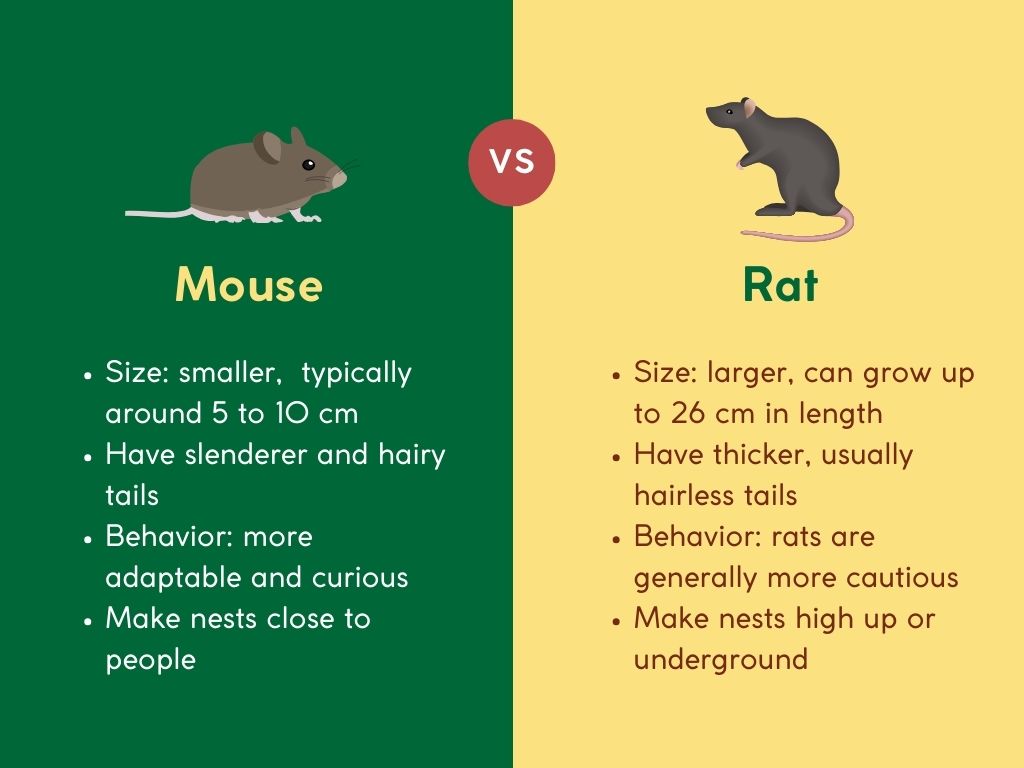
Types of Rodents in Singapore
There are 3 common rats and mice in Singapore, which are Norway rats (Rattus norvegicus), roof rats (Rattus rattus) and house mice (Mus musculus).
Norway rats are the biggest (body length range from 22 to 26 cm) among the three common species. They are also known as sewer rats, as we can always find them in the drainage system. Thus, that is one of their main travel pathways. Norway rats can be distinguished by their size, heads, ears, and tails. They have a robust body appearance, with a blunt muzzle and a shorter tail than the body.
Roof rats are famous for their climbing abilities. They are so-called agile climbers and are primarily found in elevated spaces. They have a smaller size (about 16 to 20 cm of body length), a head with a pointed nose, larger eyes, and ears similar to that of Norway rats.
The size of a house mouse is about 5 to 8 cm. Thus, they are smaller in size compared to rats. Like roof rats, mice also possess large ears and small black eyes.
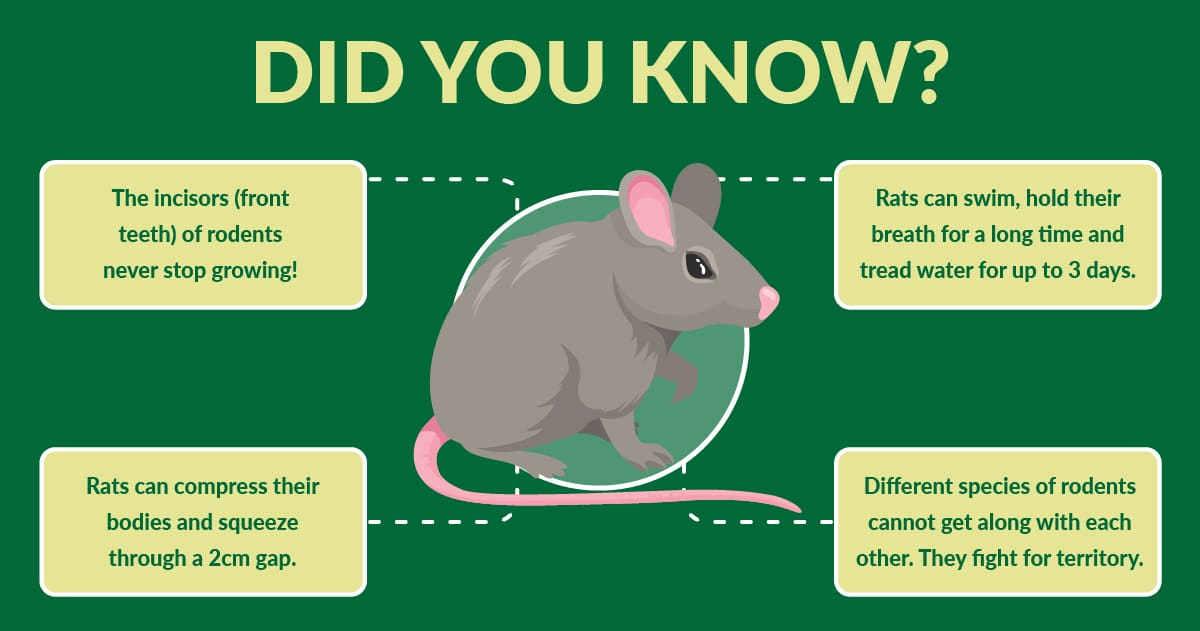
Life Cycle and Biology
Rodents are excellent in hearing, tasting, smelling and touching. However, they have poor eyesight. They are nocturnal animals, meaning that they are primarily active at night. As mentioned, rodents are smart. They explore and constantly learn, memorize food, water, pathways, nests, and the features of their environment. In addition, they have neophobia behaviour. Rodents usually avoid new objects such as traps and baits for a few days or more following their initial placement.
Norway rats are usually found at building foundations or lower levels of the buildings, especially in the basement. They are the main burrow builders and excellent swimmers. Norway rats can reach sexual maturity in about 2 to 3 months. They can reproduce and breed throughout the year in favourable conditions. One female can give birth to about 5 to 14 litters per year.
Roof rats are agile climbers who usually nest at a higher elevation, such as false ceilings, attics, cabinets, trees and dense vegetation. When roof rats invade buildings, nesting materials such as shredded paper, newspapers, and dried plant materials are used. You can always see them running along utility pipelines and overhead fence tops. One female roof rat can produce 3 to 5 litters per year.
House mice are also excellent climbers. They can even squeeze through holes of less than 1 cm in diameter because of their tiny size. House mice can have 5 to 10 litters in a single year. They can also easily enter buildings. As a result, house mice infestations are more common and severe than rat infestations.
Interesting fact: House mice infestations are more common and severe than rat infestations.
Medical Importance
Rats and mice are capable of causing structural damage and transmitting diseases (to human beings) such as:
- Rat-bite fever
- Salmonellosis (food poisoning)
- Leptospirosis
Diseases are transmitted through bite wounds, food, waste products, or indirectly by fleas, ticks and mites via close contact.
Here are some of the symptoms of rodent-borne diseases:
- Fever
- Chills
- Muscle aches
- Headaches
- Cough
- Nausea
- Vomiting
- Loss of appetite
In severe cases, some symptoms may show, such as:
- Weight loss
- Fatigue
- Swollen ankles, feet, or hands
- Decreased urination
- Shortness of breath
- Rapid heartbeat
- Jaundice
- Confused mental state
- Aggressive behaviour
- Seizures
- Inability to control your movements
- Inability to speak
- Aversion to lights
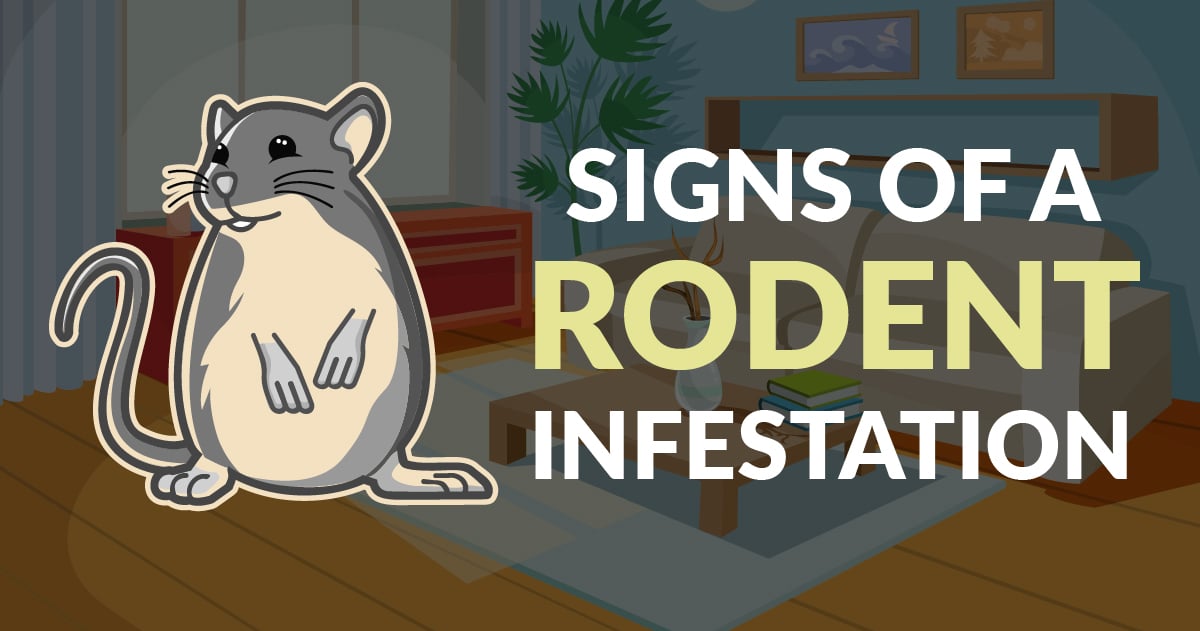
Signs of a Rodent Infestation
Rodents are nocturnal animals. We often do not notice their presence until the infestation becomes severe. Here, we will share the tell-tale signs of a rodent infestation.
1. Gnaw marks
As mentioned, the incisors of rodents never stop growing. This is one of their survival behaviours! They gnaw their incisors to gain food, and resources, invade buildings, build nests, assist in climbing and use them as weapons to fight the enemy. Rodents are seemingly attracted most to electrical wires and wooden structures.
2. Bite signs on food packaging
Rodents can bite through many food packages such as plastics, paper sacks and cardboard. Their teeth are strong and sharp enough to bite through those materials to obtain food.
3. Rodent droppings
Rodents can produce 20 and 30 droppings in a single day. In short, droppings are a good indicator to inspect for rodent activities. Furthermore, the shape and size of droppings can help in checking for rodent species.
Want to find out more about rodent control in Singapore?
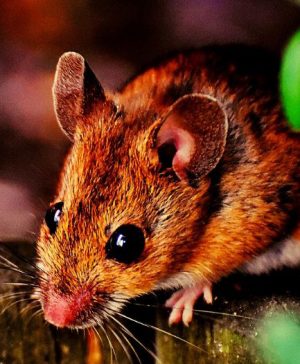
4. Rub marks
Rub marks refer to the dark grease left by rodents when they follow a trail or pathway between their nest and available food source. The dark grease or dirt marks are caused by the oily fur of rodents.
5. Urine stain and odour
In heavily infested rodent areas, we can sense stale smells coming from hidden places. Rodents use scent to mark their territory, and convey information and social dominance.
6. Burrows
Norway rats’ burrows are always found along with building foundations, especially in the external garden area. When they invade the building, they usually nest at lower elevations.
7. Live/dead rodents
Seeing a live or dead rat or mouse on your premises is a potential sign that you have a rodent infestation. Also, if you find rodents during the daytime, this may indicate that you have a heavy infestation on your premises.
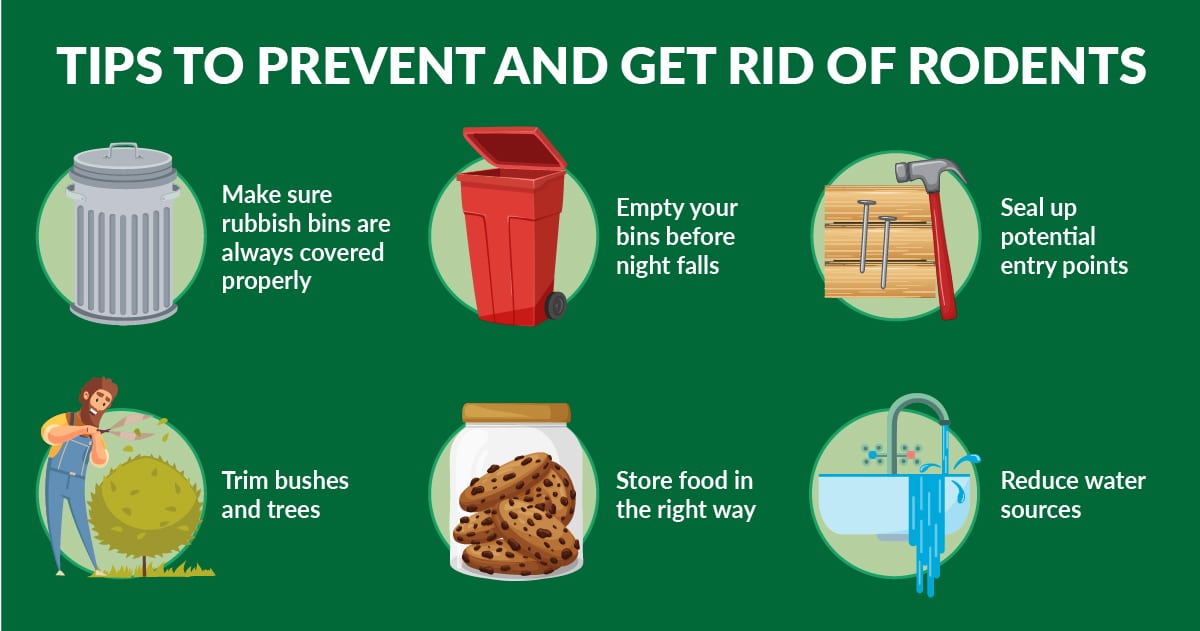
How to Prevent Rodents from Invading Your Home
You may have probably been disturbed and heard rodents squeaking at night or see them running in the kitchen area or backyard. This is because they always live near humans, searching for food that people leave behind.
As mentioned, rodents are excellent swimmers or agile climbers. For them, it is not a difficult task to find a way to invade our premises. Hence, how do we prevent them from coming in?
1. Make sure rubbish bins are always covered properly
Rodents, especially house mice, can squeeze through tiny spaces. It is advisable to always keep rubbish bins closed. As such, they are denied access and cannot gain food from bins.
2. Empty your bins before night falls
The smell of food waste in kitchen bins can attract rodents and other pests to thrive. Rodents are nocturnal pests. So, make sure food waste is always disposed of daily before night.
3. Seal up potential entry points
Both rats and house mice are capable of climbing. Therefore, make sure to inspect buildings, especially rooflines. Also, be aware of the potential rodent entry points and take necessary sealing and repairing works on the entry points found.
4. Trim bushes and trees
Rodents use thick foliage to protect and cover themselves from predators. Roof rats and house mice can climb up to buildings or premises from shrubs and trees near the exterior foundation. Hence, always make sure to trim bushes and trees around your premises to prevent giving them a favourable environment to thrive.
5. Store food in the right way
As rodents can bite through food packages, storing food in tightly sealed containers or placing food in the refrigerator is essential. The same goes for pet food, which should not be left out all day long or overnight as it will attract rodents and other pests.
6. Reduce water sources
Leaking pipes need to be fixed to reduce available water sources for rodents and other pests. The drainage system also needs to be improved if standing water is sighted and the drains are blocked. Besides, floor traps need to be covered at all times to prevent rodents from coming in through the drainage system.
DIY Methods to Get Rid of Rodents
Set your own rat/mousetrap:
- Buy traps in the market (it is recommended to buy traps that can prevent them from suffering).
- Make your own traps by referring to online tutorials (avoid catching the live one as you may need to kill or starve them afterwards).
- Choose peanut butter as the bait rather than cheese (they prefer high protein and oil-based food).
- Place traps perpendicular to walls (as that is their pathway).
- Wear removable gloves.
- Dispose of them by using tightly sealed black plastic bags.
Professional Rodent Treatment
In the case of a severe rodent infestation, treatment methods can become complicated. It is usually the combination of at least 2 to 3 methods to identify and solve a heavy rodent infestation. Help from a professional pest control company is strongly advised.
Exclusion
Identifying rodent entry points can be challenging to untrained eyes as mice can squeeze through dime-sized holes. These tiny holes can be easy to miss out on. Our pest management technicians are trained to inspect and identify the potential holes rodents or mice might use to gain food in your premises.
Rodenticides
When the rodent infestation is severe, we might need to place rodent baits outside the premise to achieve adequate control. Rodenticides are placed in a tamper-proof rodent bait station to avoid non-target animals from feeding.

Pest Problem? Let Us Help.
We offer fast and effective precision treatments to eliminate pests while ensuring a safe environment for your home or business.
Trapping
Pre-baiting
As rodents have a neophobia (bait shy) effect, pre-baiting is usually the initial stage to ensure they feed on the baits placed in the traps. The baits that we use are non-toxic and formulated with more than 15 human foods to gain attraction.
Trap with baits
After pre-baiting (usually about a few days or weeks), traps with the same baits will be activated. This stage usually proceeds until no more rodents are trapped and signs of infestation are not sighted anymore.
Our trap can send an alert to us once the rodent is caught. Then, immediate removal of the carcass can be done.
Rodents live in close association with humans and feed on whatever humans eat. Hence, you might have been providing them food without even knowing it! Therefore, maintaining the best housekeeping practice is the most reliable method to keep your premises clear from pest invasions.
However, controlling and catching rodents on your own is not a good idea when it comes to heavily infested areas. Instead, seek help from professionals now!
Frequently Asked Questions
Contact us now. Our team of experts are ready to eliminate your rat or mice problem.
Food is one of the primary reasons why rodents enter your home or office. Make sure to seal food properly and to clean areas where food is processed and eaten.
In some cases, traps for mice and rats are useful, but only if your home or office is not yet infested heavily.
Related Posts
Webinar Series: Innovative Pest Control in Singapore
Rodents

As part of our effort to educate our customers and the public about pests and the latest technology advancements in the pest management industries, we are proud to present our first three-part webinar series. In this article, we summarise the three webinars held in 2020. The first three Killem Webinars were specially designed for facility managers while remaining relevant to the general public.
Dengue, Disinfection and Distancing
The topic of the first webinar was “Dengue, Disinfection and Distancing”. In this webinar, we discussed the rising number of dengue cases in Singapore amidst the Coronavirus pandemic.
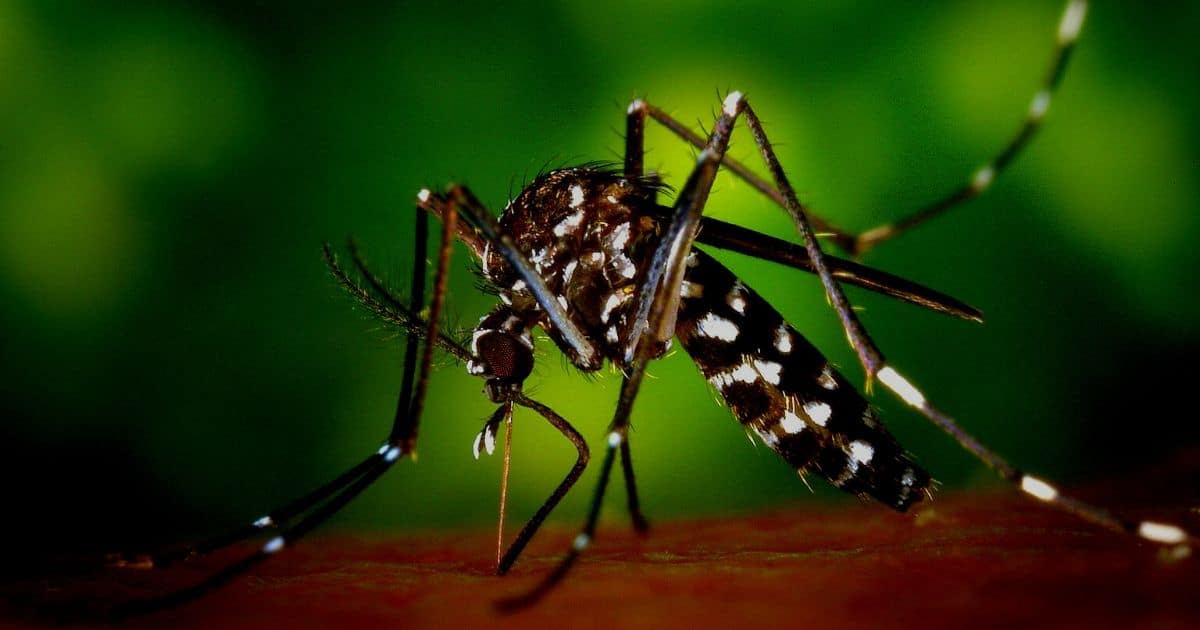
Topics include:
- The reasons behind the rise of dengue cases
- Ways to control the mosquito population
- The new norm (disinfection) that everyone is adapting now due to the pandemic
- Different types of disinfection methods
- The most critical areas to focus on during disinfection
- Things to consider when taking up a disinfection service
Q & A Session
Why is fogging still being carried out while misting treatment has a more prolonged residual activity?
Although misting is effective in areas around landscapes and plants, thermal fogging is still an effective method to kill mosquitoes present during the treatment. Thermal fogging is also used to comb a space to get rid of mosquitoes.
Can fogging be done around swimming pools?
The answer is no because the carrier of the insecticide used is usually kerosene or diesel. They cause the surface of the treated area to be oily and slippery. Therefore, carrying out thermal fogging near swimming pools may cause people to slip and fall. On the other hand, misting can be done near swimming pools since the carrier used is water and will not make the floor slippery.
Besides fogging and misting, mosquito treatment around swimming pools can be done by carrying out “Search & Destroy.” This method involves looking out for mosquito breeding sites and destroying them. Proper housekeeping around the swimming pool is also essential to eliminate harborage sites of mosquitoes.
How safe are the mosquito treatment methods?
The insecticides that we use are specifically formulated to affect designated pests. They are target-specific and will not affect other organisms like humans and animals. Proper personal protective equipment (PPE) needs to be used by Pest Management Professionals to prevent overexposure to chemicals. The small amount of chemicals that we breathe in during fogging treatment is not harmful to the general public.
What about the safety of sand granules used in mosquito control?
The sand granules are slow-releasing insecticides that can prevent mosquito breeding in locations with ponding water. They can also be placed at locations that may collect water to prevent mosquito breeding. Compared to larviciding using residual chemicals, sand granules’ action may be slower, but it can provide a longer-lasting effect.
What can be done to prevent mosquito breeding at public bin stations and bin centres?
Proper cleaning practices at these locations are important to prevent mosquito breeding. Gutters must be flushed daily to prevent the collection of water. Any uneven surfaces should be fixed so that water cannot build up. Another piece of advice from our operations director was to drill holes at the bottom of the rubbish bins so that water can escape from the bins to prevent water collection.
What are the effects of disinfectants on humans?
Inhaling small amounts of disinfectants will not have a significant effect on human health. However, we recommend avoiding overexposure to the disinfectants as much as possible. Thus, we need to ensure all safety precautions are in place and ensure no one is on-site during treatment. A treated area needs to be ventilated for one hour after disinfection is carried to allow the disinfectant particles to escape.
Is it true that certain disinfectants can last up to months or even years?
It may be true that a disinfectant can stay effective for a promised timespan. However, other factors may cause it to lose its effectiveness. For example, when people frequently touch a surface, the disinfectant on it may be wiped off. Besides, other pollutants such as dust and dirt may also contaminate the surface.
Want to find out more about mosquito control in Singapore?
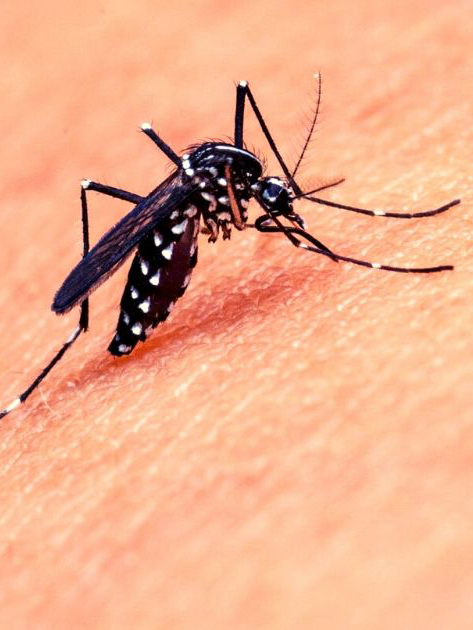
Cockroaches and Termites
In the second webinar, we discussed cockroaches and termites. These two insects are commonly encountered in our lives.
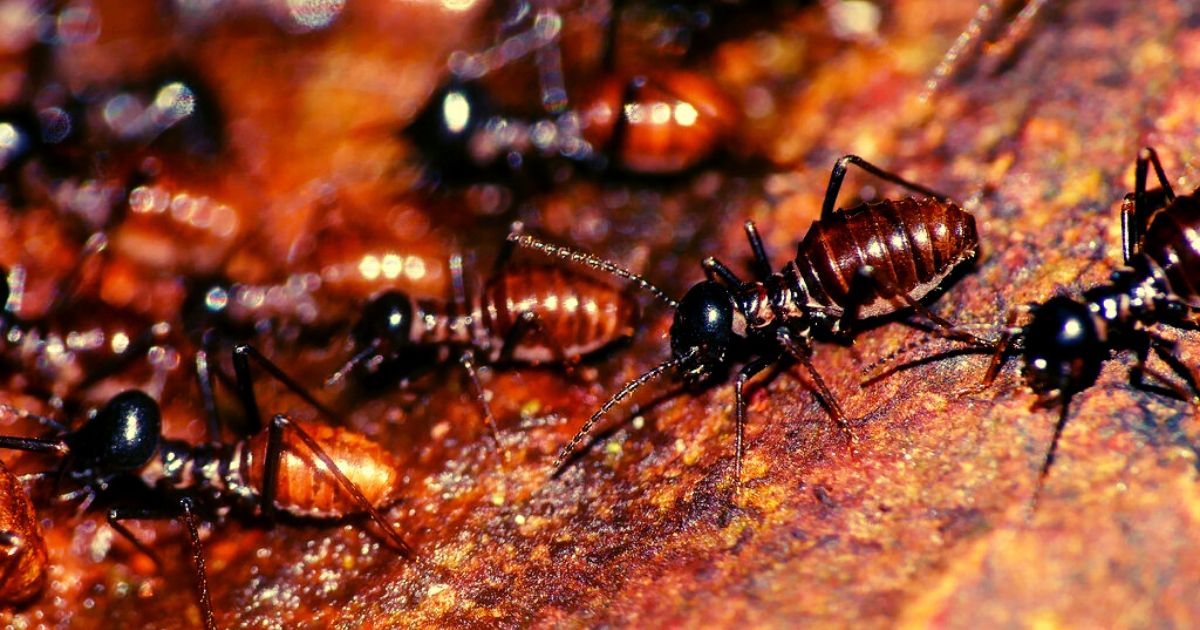
Topics include:
- Biology
- Prevention tips
- Technologies and treatments for the pests
Q & A Session
What is the hatching time of cockroaches’ ootheca?
The time needed for the ootheca to hatch differs between species. However, the typical household species take approximately 20 to 30 days to hatch into young cockroaches.
What is a suitable cockroach treatment method for a pneumatic waste collection system in high-rise buildings?
One of the latest treatment methods for cockroaches is using a product called Mirakn. Mirakn is applied using a dry spraying treatment. It consists of only the active ingredient and carbon dioxide as its carrier, making it an environmentally friendly insecticide that is stainless, odourless and non-combustible.
The carrier gas allows the insecticide to have excellent penetration. In addition, it can reach narrow gaps that are inaccessible via other treatment methods. Mirakn is safe for humans and pets, but the treated area should be left vacant to minimise exposure to chemicals.
Pro Tip: Methods used by professional pest control companies offer long-lasting protection against cockroaches.
All our Pest Management Professionals have undergone specialised training before they could become certified applicators of Mirakn. The frequency of Mirakn treatments at bin chutes can be affected by several factors. Depending on the infestation level and sanitation level, premises may need more frequent treatments to keep the cockroach population under control.
How to differentiate between subterranean termite and drywood termite infestations?
The signs given off by the infestations of these two groups of termites are different.
For subterranean termite infestations, the most distinguishable sign is the presence of mud tubes or soil-like materials in the infested area. The mud tubes are passageways constructed by subterranean termites to travel from one point to another. The most common sign of infestations by drywood termites is the presence of faecal pellets that resemble sawdust around the infested items or structures. The exit holes where the faecal pellets are pushed out of the infested wood can also be seen on the surface.
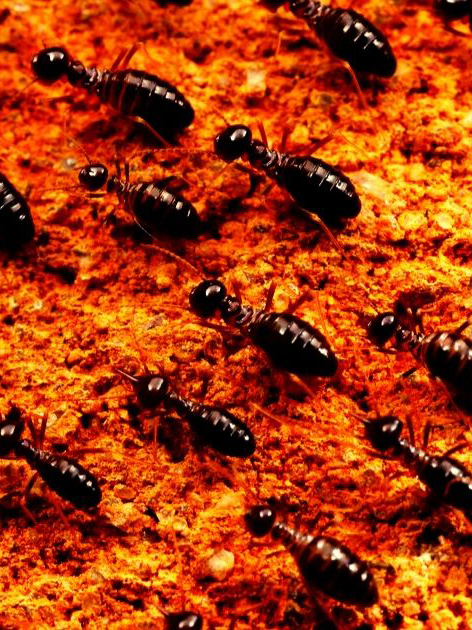
What are the effects of termiticides on plants and the surroundings?
The termiticides that Killem uses are Green Label certified. This guarantees that they are environmentally friendly. Besides, we strictly follow the termiticide’s recommended dosage to prevent harm and pollution to the environment.
What are the potential risks of the baiting treatment program for pets?
The active ingredient of the baits used for subterranean termite treatments targets the moulting process of termites. Animals with endoskeletons, such as dogs and cats, do not undergo a moulting process. Thus, pets are not affected by the baits.
How many bait stations need to be deployed in a heavily infested unit?
Subterranean termites live underground. Mud tubes are used for foraging. Therefore, although many mud tubes are found in a unit, they may belong to the same colony. Just one bait station is needed to control the termites in this unit. The termites will feed on the bait and bring the bait back to the nest. In turn, the bait is shared among the colony members.
Rodents: The Year of the Rat
In the third and last webinar, we focused on rodents. In this webinar titled “Rodents: The Year of The Rat’, we were honoured to have Dr How Yee Fatt as one of the speakers. Dr How is one of the leading entomologists in Singapore who is also the Business Support Manager (Technical R&D) of Bentz Jaz Singapore.

During the webinar, we discussed the biology and signs of rodent infestations. The speakers also shared several innovative prevention and management solutions. Killem Pest offers a special rodent monitoring and control system known as IPM square.
Q & A Session
What are the advantages of choosing IPM Square systems over other rodent monitoring systems?
There are many rodent monitoring systems in the market. The IPM Square Rat differs from the others as it incorporates snap traps with the use of sensors. While the system is detecting rodent activities, it simultaneously traps rodents and protects your house from infestations.
The IPM Square Rat is the camera used in rodent monitoring. It is highly intelligent and is able to recognise rodents using technology similar to facial recognition for humans. This technology enables accurate monitoring of rodent activities.
How do the monitoring systems work when there is a breakdown in the power supply or Wi-Fi networks?
The monitoring sensors and cameras are battery operated. Thus, they can function without a power supply. The outage of the Wi-Fi system may disrupt the monitoring systems since the data is continually being uploaded to the cloud servers.
However, the monitoring cameras have memory cards in them. Thus, they are still able to record the footage and store them in the local device storage. Users can also still review the footage by retrieving the local memory card and going back to a timeframe in the past.
How often should the rodent flush-out program be carried out?
The rodent flush-out program is an intensive program to manage rodent infestations. Depending on the infestation level, we have clients that require rodent flush-out programs with frequencies ranging from twice a year to monthly. Premises with heavy rodent infestations require more frequent rodent flush-out program applications. Routine maintenance can also help keep rodent populations under control.
Are glue boards safe for use in childcare centres?
Proper treatment methods are the key to ensuring treatment is safe. Glue boards should be strategically placed. Examples include the false ceiling or inside tamper-resistant bait stations (only accessible to Pest Management Professionals). The glue board method is applied to:
- Ensure the effectiveness of the control program
- Minimise the impact on the residents
Besides cages, are there any other rodent prevention methods for the garden or other outdoor spaces?
The tamper-resistant rodent bait station is a useful tool for rodent control. Rodenticides or traps are placed inside the station. Then, the station is placed in the garden. The bait stations prevent other animals, such as cats and dogs, from consuming the bait or activating the traps. Fallen leaves can serve as a home for rodents. Thus, keeping your garden and outdoor area clean and tidy is also important.
What is the rodent sealant?
During the webinar, we introduced a rodent sealant. This sealant can remain on the treated surface as long as there is no external disturbance. However, the sealant should be replenished or reapplied if it is disturbed by rodents or even humans. The sealant has a mild smell that repels rodents and is not detectable by humans during daily activities. The sealant has a shelf life of approximately five years. To maximise its shelf, proper closure and storage is recommended.
Is it possible to have more than one rodent species infesting a house?
Yes, it is possible. However, the rodents will nest at different locations. Roof rats and Norwegian rats are commonly found in Singapore. Roof rats (as their name implies) spend their time at higher elevations such as attics and false ceilings. Norwegian rats form burrows on the ground, or they nest in the sewers. The two species will not have the same nesting site as they are territorial.
What is the difference between shrews and rodents?
Shrews are animals that resemble rodents. Unlike rodents, shrews will not chew on wires or other items as they have different body structures. Shrews feed mainly on insects and other small animals such as birds, snakes and even rodents. Shrews are less likely to carry diseases because their behaviours are different from rodents. Rodents feed on a wide range of food, including rubbish and waste. They are commonly found in areas with poor sanitation such as the sewer and waste collection sites, which increases their chances of contracting various pathogens.

Pest Problem? Let Us Help.
We offer fast and effective precision treatments to eliminate pests while ensuring a safe environment for your home or business.
Related Posts
Fumigation Treatment: All You Need to Know
Rodents

The never-ending battle between humans and pests has led to the rapid development of pest management services in Singapore, including fumigation treatments. The wide-ranging pests and their nature of behaviour can interfere with human activities.
The difficulties of controlling pests – due to the limitation on certain treatments’ application – has led us to using fumigation treatment to deal with severe pest issues.
Fumigation treatment in Singapore is usually carried out in the freight, shipping, storage and food manufacturing industries. All fumigators must apply for training and a licence from the NEA (National Environmental Agency). Beyond that, pest management companies are also responsible for the application of fumigation permits before they are allowed to carry out fumigation treatments in Singapore.
Fumigants in Singapore
Fumigation treatment is a unique form of action for pest management.
It is usually adopted by pest management companies and clients when there are no other feasible forms of control to the target pest. However, most fumigants such as hydrogen cyanide, methyl bromide and hydrogen phosphide are toxic to pests as well as humans. Nevertheless, fumigation treatment has effective killing effects and has become an inevitable pest management method in Singapore.
Mode of Action of Fumigation Treatment
Fumigation treatment is a process of release or dispersal of toxic chemicals onto the targeted pests. It can be very fast as the volatile nature of fumigants is able to pass through inaccessible spaces. It has almost no limit to penetrate any object as long as tiny pores are present on the surface of the treated object. In other words, the entire structure is secured with the fumigation treatment. The toxic chemicals enter the pest body mainly through its breathing system.
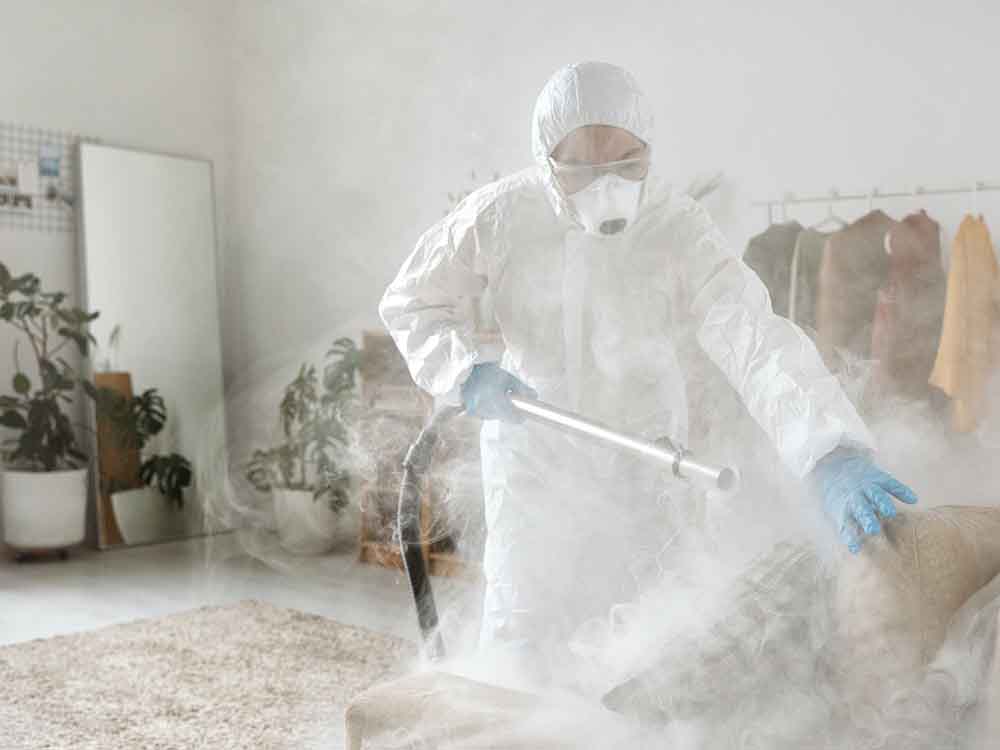
Target Pests in Fumigation Treatment
In general, fumigation treatment is helpful in dealing with all types of pests including stored product pests, wood borers, subterranean and drywood termites, bed bugs, cockroaches and even rats. It is often carried out in enclosed shipping containers, vessels and warehouses.
Fumigation on smaller structures such as infested wood and furniture is usually done for targeting drywood termites and wood borers. In this case, infested wood has to be removed and placed in an air-tight space to allow the proceeding of fumigation treatment.
Want to find out about pest maintenance programs in Singapore?
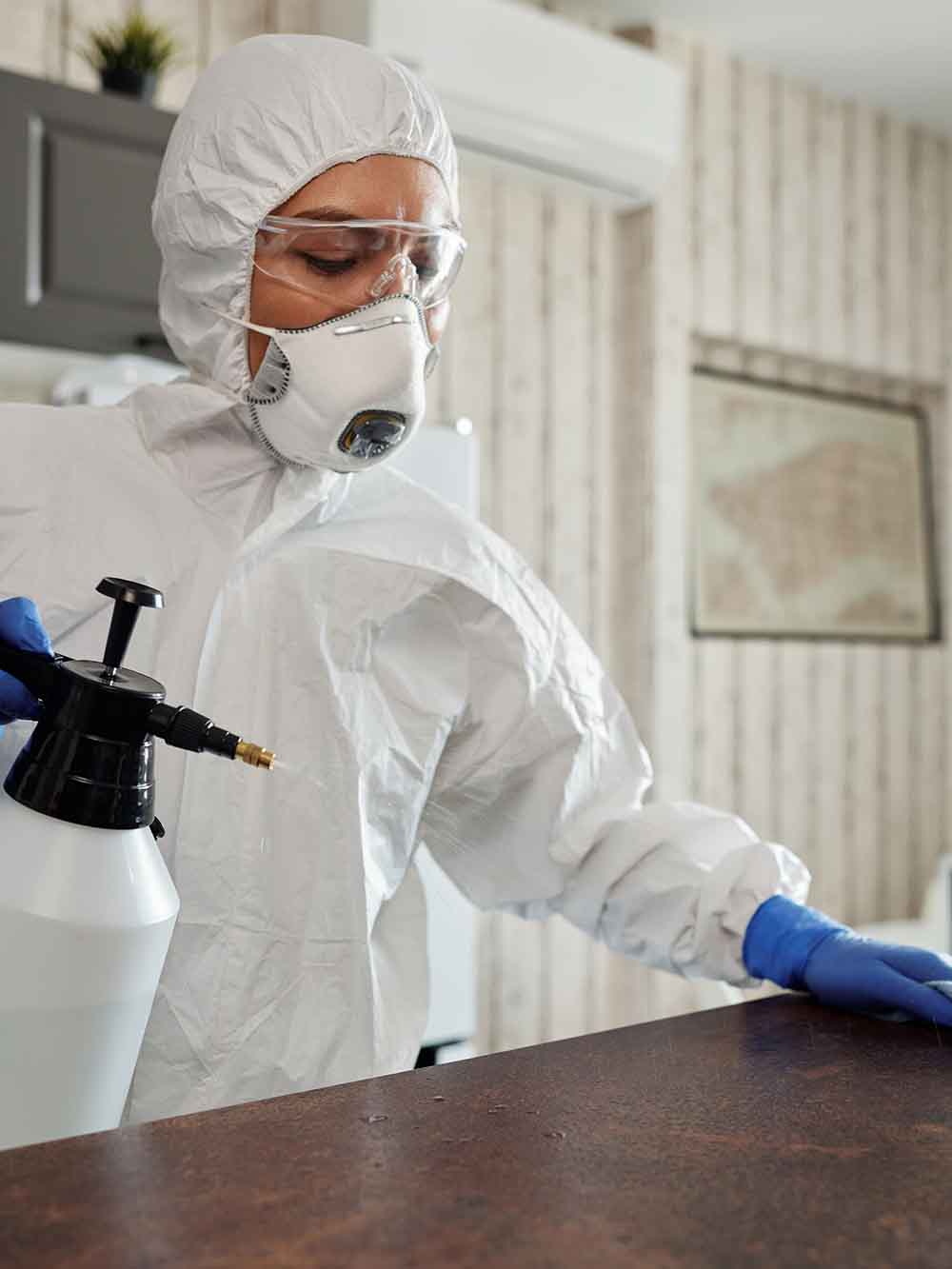
Disadvantages of Fumigation
One main disadvantage of using fumigation treatment is that there is no residual effect on the treated structure. Therefore, no residues remain in the treated spaces once the areas have been ventilated and cleaned properly. Hence, it does not help in protecting the treated structure from future pest infestations.
Since the knockdown effect of target pests depends on its respiration rate, low temperature of the treated environment may make the pest less susceptible. This is due to the fact that the lower the temperature of the surrounding, the lower the respiration rate of the pest.
Pro Tip: It's better to hire professional pest management services to ensure the fumigation treatment effectiveness.
Factors Contributing to Fumigation Failure
Fumigation failures are common. It can be due to the improper application and pest resistance. In addition, inappropriate choice of fumigants and loss of fumigant through leakage in treated spaces can also affect the effectiveness of the treatment. Hence, a leak detector is sometimes utilized before the treatment.
Final Note
Fumigation treatment, while seen to be effective because of its volatile and gaseous nature to target pests, can actually be harmful to human and pets. The excessive use and misuse of the fumigants not only pose harmful effects on human’s health but cause adverse effects on the treated commodity and property.
The use of it must be handled by trained and certified fumigators as they will have enough knowledge on its application and precaution steps before and after the treatment.

Pest Problem? Let Us Help.
We offer fast and effective precision treatments to eliminate pests while ensuring a safe environment for your home or business.
Careful planning and application must be adopted before the treatment is carried out. The appropriate choice and use of fumigants are vital as it may cause fumigation failures and hazards to the environment.
Frequently Asked Questions
Fumigation treatment is usually required in freight, shipping, storage and food manufacturing industries. Businesses in these industries must avoid the spread of pests and minimize the risk of damage to the goods or people’s health.
Fumigation treatment usually lasts for years, but it is recommended to have regular inspections to keep the areas protected.
It is important to remove plants and pets before fumigation, and also all the food and medicines that are open and/or are not sealed.
Related Posts
7 Tips to Keep Mice Away
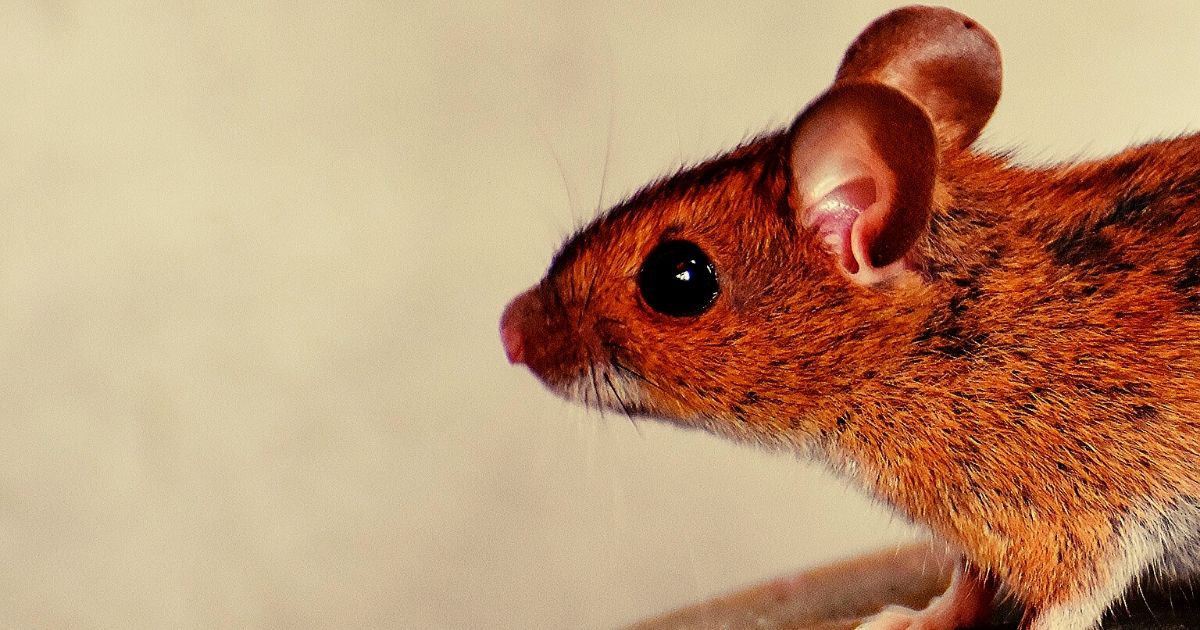
Rodents
While mice are portrayed as characters in many popular cartoons and movies, they are not as welcome in our house as on the big screen. Mice belong to the family Rodentia which houses many other animals such as rats, squirrels and hamsters. Among all rodents, mice and rats cause the most problems to the urban environment, thus making them an important urban pest.
Table of Contents
Mice species
The most common species of rodent pests found in the urban environment are the house mouse (Mus musculus), roof rat (Rattus rattus) and Norway rat (Rattus norvegicus). The house mouse can be distinguished from the other two species through several characteristics. They are small (5 to 7 inches long) and are usually light brownish to grey in colour. Mice possess relatively large ears and small black eyes. They are relatively smaller in size when compared to rats.
These small critters need to be taken seriously, not only due to being a nuisance and or their ability to transmit diseases such as leptospirosis, but also because they can cause structural damages to buildings.
There are several things that you can do to keep them away from your house.
Want to find out more about rodent control in Singapore?
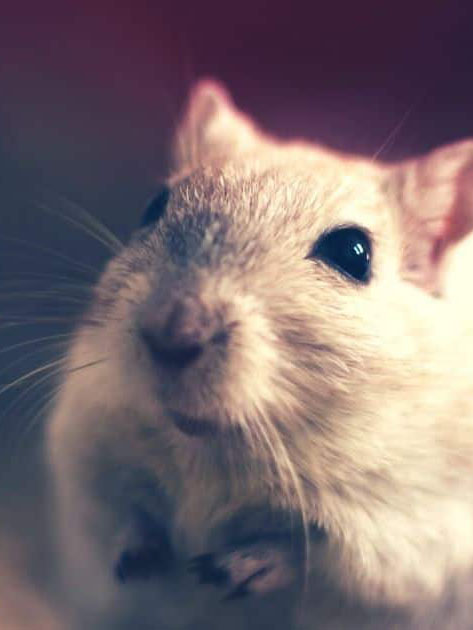
1. Inspect your house and its surrounding for signs of infestation
Droppings, gnaw marks and tracks are the most obvious indications of a mouse infestation. The droppings are small, usually less than 6.4mm. Similar to other rodents, mice practice gnawing behaviour to file down their teeth. They tend to chew on wooden structures and wires and this can cause serious structural damage as well as fire hazards.
2. Always make sure doors and windows are properly closed
We should always keep the doors of our house closed to prevent unwanted guests from entering. Windows should be shut whenever there is no one home so that you will not come back home to find “new tenants” in your house.
Mice are agile climbers so they will have little problem climbing up the windows and making their way into your house.
3. Seal up all possible entry points of mice
Mice are so small and their bodies are so flexible that they are able to squeeze through openings that are as small as ¼ inches across. Besides closing all the doors and windows, other possible entry points should be sealed up to prevent them from entering the house. The possible entry points may be gaps around pipework, holes on the roof or even the gap between doors and the floor. All openings that may serve as entry points for mice should be sealed with materials that cannot be gnawed down by mice, for example, cement and wire mesh that is smaller than ¼ inches to deny their access.
4. Keep all food airtight
A mouse will feed on whatever humans eat. By leaving your food uncovered, you are making your house vulnerable to the infestation of various pests such as mice, ants, flies and cockroaches. Make sure your food is properly stored to prevent not only pests but also germs.
5. Dispose of food wastes properly
Mice are not as picky as we are when it comes to food. They will be attracted to, and happily feed on, the food wastes we leave behind. Proper disposal of food wastes is important as it will make your house less favourable to them due to the lack of food sources. Always practice good waste management to keep the rubbish chute and bins in your house free of mice as these are the popular locations for mice to forage for food.
Pro Tip: You need to rodent-proof your property, otherwise the mice will keep coming back.
6. Get rid of possible nesting sites for mice
A house mouse nests in sheltered locations and constructs its nests using shredded paper and other fibrous materials. If you recall the scenes from cartoons, the “house” of a mouse is always a hole or opening located at the bottom of a wooden wall. A mouse hole is one of the places where mice can be found because they are able to gnaw through wooden walls to construct their nests inside the hollow spaces behind the walls. By clearing all rubbish and sealing all holes or cracks around your house, you can prevent sharing your house with these sneaky critters.
7. Use traps
If your house is already infested with mice, traps can be deployed to remove them from your house. Some of the traps that can be used include snap traps, glue traps, cages and electrocution traps. The placement of traps is crucial to the success of the traps. Traps should be placed behind objects, in dark corners and at edges near walls because mice tend to move about touching the wall. Furthermore, attractants can be placed to increase the success rate of your traps.
In order to keep mice away from us, it is important to stay vigilant and be mindful towards the surrounding environment.

Pest Problem? Let Us Help.
We offer fast and effective precision treatments to eliminate pests while ensuring a safe environment for your home or business.
Early detection of activities facilitates the prevention of infestation and management of their population. Poor sanitation is always the cause of infestation so by practising good sanitation practices, we will be able to keep mice away from us.
Frequently Asked Questions
Mice can get into the house through gaps and cracks in the foundation, walls, roof, etc, or through the holes around the pipes.
Mice don’t usually bite and are not aggressive unless they get disturbed and feel threatened.
Mice are not likely to leave on their own if your house has favourable conditions, so you will need to hire professional pest management services to get rid of them.
Related Posts
7 Tips for Keeping Our Bins and Bin Chutes Free of Rodents
Rodents

Table of Contents
- 1. Mindful Placement of Bins
- 2. Always Keep Bin Lids and Bin Chutes Sealed Properly
- 3. Get Broken Bins and Bin Chutes Hoppers Replaced or Repaired
- 4. Make Sure Your Bins are Always Clean
- 5. Do Not Let Food Sit in the Kitchen Bin for too Long
- 6. Bag Your Food Waste
- 7. Do Not Let Bins Overflow
- Bonus Tip: How to Seal the Rubbish Chutes in Buildings
In our effort to become a garden city, plants and greenery have been incorporated into the buildings and structures around Singapore. With all these plants around, they provide opportunities for other organisms to thrive. While many of these organisms such as birds and butterflies might be harmless or even beneficial to us, some might cause problems to humans.
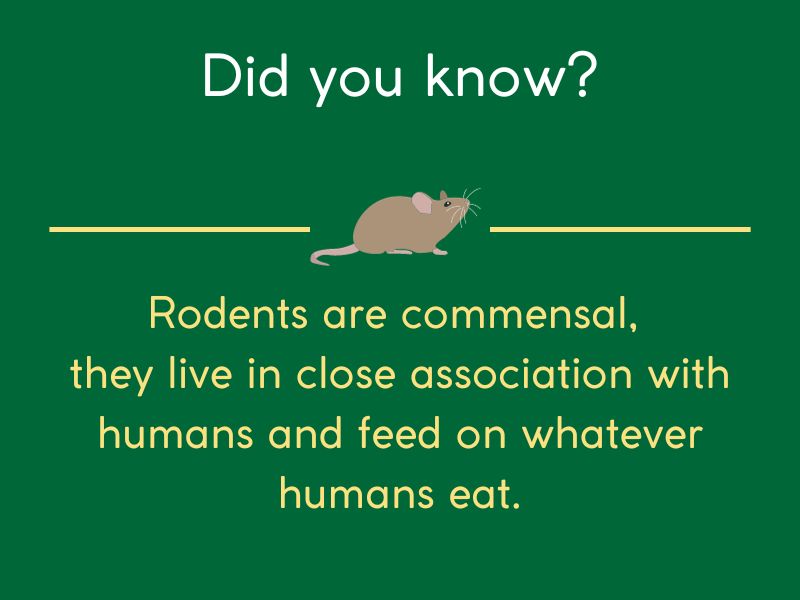
Rodents nest in burrows in the soil where plants grow in. In our effort to bring greenery close to our living environment, rodents are also closing in on our lives.
They pose public concerns as they are not only capable of transmitting diseases such as leptospirosis and rat bite fever but also causing structural damage when they chew on wires and other building structures.
You have probably seen rodents running around residential areas or at the void deck of flats, or heard them squeaking in the middle of the night. This is due to the fact that rodents are commensal so they live in close association with humans and feed on whatever humans eat.
You might have been feeding rodents without even knowing it. They scavenge for any food that you throw away so the rubbish bins and bin chutes might be their favourite haunt for nice, free food.
How do we keep rodents away from bins and bin chutes?
1. Mindful Placement of Bins
Rodents might perceive the placement of bins near windows and doors as an invitation so you might want to make sure the bins are kept away from the entrances. Avoid exposing the bins to direct sunlight to help reduce the smell of food.
2. Always Keep Bin Lids and Bin Chutes Sealed Properly
Rodents are so flexible that they can squeeze through a space as thin as a pencil so it is important to make sure that the bins have been completely sealed.
Furthermore, rodents are excellent climbers that are able to climb walls with a rough surface. Be sure that the bin chute hoppers are closed tightly so that these unwelcomed guests are unable to gain access to the upper floors.
Pro Tip: Metal bins and containers with tight-fitting and secure lids are the most secure way to keep rodents away.
3. Get Broken Bins and Bin Chutes Hoppers Replaced or Repaired
If bins are cracked or broken, have them replaced as the cracks serve as open doors for the rodents. Faulty bin chute hoppers should be repaired to make sure that they can always be closed tightly.
4. Make Sure Your Bins are Always Clean
Cleaning your bins regularly and rinsing them with disinfectant and hot water is a good way to get rid of the smell that attracts rodents while removing any pathogens present around the bins. Killem offers bin chute flush out treatment to control the population of pests that are commonly found in bin chutes.
By having clean bin chutes you can have your mind at peace as you will not have to constantly worry about pests sneaking into your house from these places.
Want to find out more about rodent flushout services in Singapore?
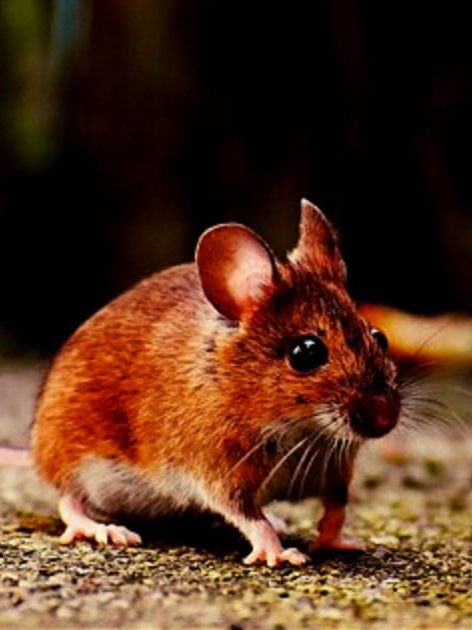
5. Do Not Let Food Sit in the Kitchen Bin for too Long
Kitchen bins with food waste attract rodents and other pests such as flies so it is important to empty them regularly.
6. Bag Your Food Waste
Throwing food waste into garbage bags or plastic bags will help isolate their smell while keeping the bins and bin chutes clean.
7. Do Not Let Bins Overflow
Garbage should always be inside the bins and not be left exposed. Rodents are capable of biting through the garbage bags so make sure the garbage is always contained inside the bins.
By giving a little bit of extra attention to the bins around us, we will be able to keep these unwelcome guests at bay.
Bonus Tip: How to Seal the Rubbish Chutes in Buildings
Sealing a rubbish chute is a common maintenance task in multi-story buildings as they can become a source of rodents and other pests. As time goes by, rubbish chutes can get cracks or gaps that become an entry point for pests into your home. To prevent this from happening, it’s important to conduct routine inspections and promptly seal any detected cracks or gaps.
To seal the rubbish chute, you first need to inspect it for any missing parts and replace them if needed. Seal the gaps and joints around the rubbish chute and the chute door. Regularly maintain and reapply the sealant to keep the chute effectively sealed, preventing odors and pests from escaping.

Pest Problem? Let Us Help.
We offer fast and effective precision treatments to eliminate pests while ensuring a safe environment for your home or business.
Frequently Asked Questions
Yes, rodents get attracted to compost and garbage bins as a source of food and shelter for them.
Rodents can climb almost anything, except smooth surfaces. This means that if you put boxes, plastic bags with garbage, or anything else near the bins, chances are that rodents will easily climb into your unsealed bins.
Rodents are not able to chew through hard plastic, so your trash will be safe in plastic bins. On the other hand, they can easily chew through soft plastic, paper, and cardboard, so don’t store your garbage in those.
Related Posts
The Biggest Jobs in Pest Control History
Rodents

Singapore may be currently experiencing a rise in rodent populations due to an increasing human population (therefore an abundance of food and shelter), however, we should count ourselves as lucky as this is nothing compared to some of the pest control jobs below…
Rooting out the Rats
The Rat Islands; an unappetizing nickname for a place overwhelmed with unsavory creatures. Located in southwest Alaska, the Aleutian Islands were infested by rats after a fishing vessel arrived on the coast and accidentally introduced the population into the ecosystem in 1780.
With few natural predators, the rat population flourished and numbered into the thousands, decimating the local seabird numbers.
An invasive pest, rats were recorded by subsequent voyages throughout the 19th century and continued until the 21st.
Annoyed by the scourge, the federal government of the United States teamed up with local conservation groups and launched a $2.5 million project that involved state-of-the-art technology and chemical trickery.
Rats are intelligent creatures; if a food seems poisonous, the rest of the population will avoid it. In order to trick the rodents, scientists placed a slow-acting toxin in grain pellets that would take five days to act. Within a few weeks, the rat population died underground in their burrows, restoring the natural ecosystem.
Pests are invasive and, when left unchecked, can wreak havoc on entire islands.
The Argentinian Plagues
Argentina is a South American nation that experiences annual locust problems due to the warm, wet climate and agricultural economy. The locusts breed in the forests, spreading their offspring each year and raiding farms for food. However, previous insurgencies were nothing compared to the epidemic that struck the nation in 2016.
Clouds of locusts ranging from four miles wide to two miles high could be seen across northern Argentina, and boded ill for farmers who soon found their homes surrounded by young.
Fumigators in 66 counties spent a month working for Senasa – the Argentinean agricultural agency.
Hundreds of thousands of dollars were spent combatting the plague before it could descend upon farmers, sparing them the loss of crops worth millions.
However, this was not the end for Argentina. Despite their efforts, fumigators missed large chunks of the population. Helicopters were called in to spread pesticides throughout the countryside, adding even more expense to the already costly infestation. Argentina’s problem is a prime example of a simple maxim: do not let a pest population grow out of control.
Pro Tip: Pest control should be left to pest management professionals.
Four Small Pests, One Large Failure
Good intentions can have bad outcomes. In 1958, leader Mao Zedong introduced the “Four Pests” campaign designed to target four creatures that spread disease and damaged crops in China. Mosquitos, rodents, and flies were common pests eliminated through traps and poison.
Sparrows were the fourth “pest” but would have drastic consequences.
People would destroy nests and baby sparrows, shoot the birds, or prevent them from sleeping by drumming until they fell dead from the sky. The scale of this operation was enormous – truly one of the greatest pest control jobs in history. Millions of people engaged in competitions to see who could eliminate the most pests; the winners were rewarded.
By 1960, severe ecological damage had been wrought. Rice, the staple crop, withered and was devastated by hordes of insects that no longer had their natural predator, the sparrows. Poor pest control, in combination with misused pesticides and deforestation, led to a famine that killed between 20-40 million people.
If you have a pest infestation that is beyond your control or other pest control providers have not given effective solutions, please get in touch with us. There is a reason our motto is: “When all else fails, Killem prevails”. We are confident that we can provide the most effective and least disruptive solutions to your pest problems.

Pest Problem? Let Us Help.
We offer fast and effective precision treatments to eliminate pests while ensuring a safe environment for your home or business.
Related Posts
Killem Pest Profile: How to Identify and Remove Rats and Mice
Rodents
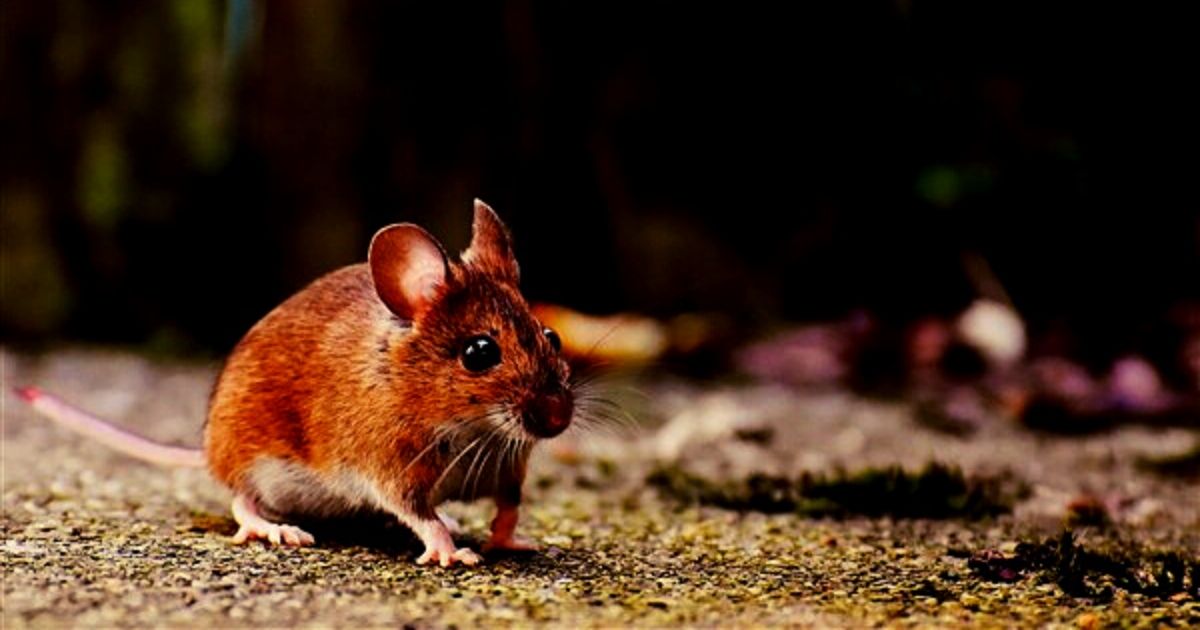
In the pest control industry, we use the term ‘rodent’ or ‘rodents’ to refer to both mice and rats. Rodents are becoming a rising concern in Singapore due to a very dense population and therefore an abundance of food and shelter that they can find.
The NEA has even set up a special task force to coordinate and monitor rodent control in Singapore. Below we take a look at the biology and behaviour of rats and mice.
How many types of rats are there?
There are at least 60 types of rats in the world. Two of them are particularly active in Singapore: Black and Brown rats.
Rats belong to the rodent species. Worldwide, there are about 1500 types of rodents. It is also worth noting that there are about 7 billion rats in the world.
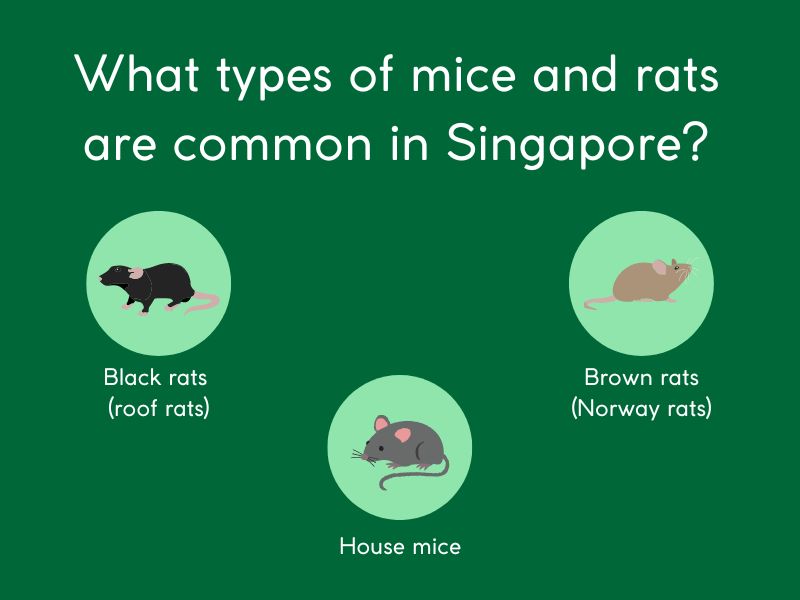
What types of mice and rats are common in Singapore?
- Black rats, also known as roof rats
- Brown rats, also known as Norway rats
- House mice
How to Identify Mice
Singapore has only nine native rodent species, but animals from other regions have invaded and constitute some major pests.
One of the most common species is the house mouse.
The average mouse weighs half an ounce and can range from 5.5 to 7.5 inches long.
They come in a variety of colours, ranging from white to brown to grey. Because of their size and natural predators, they have keen senses of smell, sight, and hearing, and are cautious around people.
They also make excellent escape artists, being able to squeeze through holes in the walls, slip under doors, and even climb into cabinets.
Part of what makes them a difficult pest to deal with is their reproductive capacity: one female mouse can have 5-10 litters every year, producing 5-6 offspring each time. In total, this means one pair of mice can have 25-60 children in 12 months.
Although they may appear small and fluffy, mice are not pleasant inside homes or workplaces.
Their faecal matter contains the bacteria necessary to contract salmonella, and they can spread it to food through their feet.
While their diet primarily consists of grains, they will nibble on a wide variety of foods, making them common kitchen pests. Often living in basements, attics, and walls they sneak out from their dens when the homeowners are sleeping and inactive to search for food.
How to Identify Rats
Rats are often confused with mice but are considered a more serious threat. In Singapore, the most common types of rats are the Norway Rat and the Roof Rat. The Norway Rat weighs roughly 1.1 pounds and is usually brown or grey with a scaled tail and ears. They live in underground burrows to breed and often seek out the food sources that can be found in homes, restaurants, shopping centres and commercial buildings.
Their counterpart, the Roof Rat, is slightly smaller at 12 ounces and tends to be black or grey. They also live in underground burrows, but are adept climbers and can roost near roofs, giving them their name. Both rats are longer than mice and are prolific breeders, producing 32-84 offspring a year. Like mice, they are agile and can scurry, jump, hide, and climb through small spaces.
One of the key differences between a rat and a mouse is the scales present along with rats’ ears and tails, as well as the longer body and higher weight. Rats also possess large teeth that they use to bite; their bites transmit diseases like rat-bite fever. Salmonella from faecal matter is also a threat, and rats can host fleas, presenting another pest problem if left unchecked.
Want to find out more about rodent removal in Singapore?
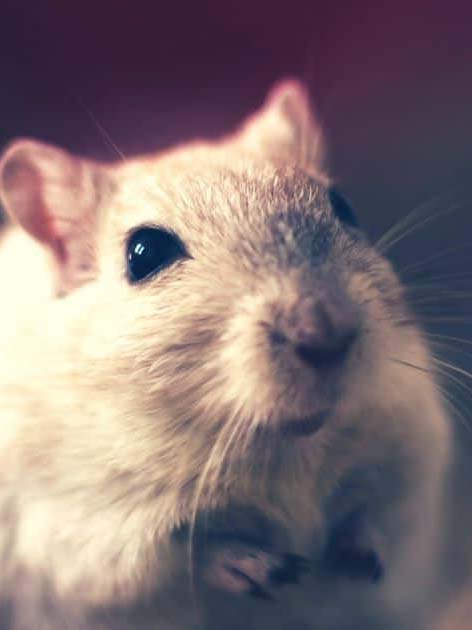
Signs of Rodent Infestations and Prevention Methods
One of the first signs to look for is rodent droppings. These should never be touched as they are full of bacteria and can transmit viruses like Hantavirus Pulmonary Syndrome (HPS). House mouse droppings are the smallest at one .25 inches with pointed ends.
The Roof Rat is also pointed but is roughly .5 inches long. Finally, the Norway Rat has the largest faeces at .75 inches with rounded ends, making them more distinguishable from the other two.
If droppings are found in the home, there is likely a habitat nearby.
Chew marks on food packaging and furniture are another sign of rodents, as are grease marks near cracks and holes, which indicate that rodents have been using them as entry points. If squeaks and rustling are heard in the walls, that is another hint.
Pro Tip: To keep rodents away, keep your building areas clean and make sure to limit access to food.
Sanitation can help prevent mice and rats from infesting homes, restaurants, and other buildings, but it does not assure that problems won’t occur. To truly prevent rodents, buildings need to be designed and sealed so the pests cannot access food. Any food should be sealed in tight containers and kept high in cabinets or fridges. Walls should be properly caulked and holes should be filled immediately.
If these methods fail, calling an exterminator to set traps and find nests is the final and most effective option. Pest control providers can use glue boards that will trap the creatures on a sticky surface, snap traps, and rodenticides that will poison the rodents but are kept away from areas accessible by children and pets.
Killem has carved a niche for itself with our rodent maintenance and flush-out programs. Do check our rodent pest control page for more information on rodent control.

Pest Problem? Let Us Help.
Frequently Asked Questions
Yes, if there’s plenty of food for both populations, rats and mice can inhabit the same area at the same time. However, if the resources are limited, rats can kill mice.
Yes, rats are much more difficult to get rid of than mice. For example, rats can eat from a mouse trap without making it go off. They are also more intelligent and can stay without food or water for a longer period of time.
Rats and mice can damage electrical wires and appliances, furniture, books, etc. They can also make you sick as they spread disease and transport fleas, lice, mites, and ticks.
Related Posts
What Common Pests Are Found in Your Garden?
Rodents

You may love spending time in your backyard and tending to your garden. Your children and pets also enjoy playing outside. Perhaps you grow flowers, or vegetables and fruit for you and the family to eat. However, many different types of pests enjoy the garden just as much as you do, and that can be a problem. Let’s take a look at some of the most common pests that like to hang out in the garden.
Table of Contents
Bees and Wasps
If you see a bee or two in your garden, it’s not usually a sign to worry. In fact, bees are essential for pollination, and they can do your garden, and the rest of the gardens in the area, a favor. However, when it comes to wasps, or if you have too many bees that are causing problems, you may want to contact a bee or wasp removal specialist to have them removed because the stings are not only painful, but may also be fatal to people that are allergic to bee and wasp stings.
Snakes
Most people hate seeing snakes in the garden, and they do have the potential to be a problem.
If you have non-venomous snakes that are small and not overly aggressive, they can help to control the rodent population, which is another garden pest we will discuss.
However, if the snakes are venomous, if it is very big, if you are unsure about them, or if you simply have a fear and dislike for snakes, you should have them removed as soon as possible. This is an especially good idea if you have children or pets.
Termites
If you notice termite mounds in your garden, this is a very bad sign and an indication that you already have an infestation. While those termites will not be interested in the flowers and vegetables you are growing, they will be interested in marching to your house so they can start eating the wood so get a termite control specialist in to remove them as soon as possible.
Rodents
Rodents in the garden can be very destructive. They may start to eat at the items you are growing, and they are disease carriers. Nothing good comes from having rodents in the garden, and they may also decide to move inside your home where they can get at even more food and cause more issues.
Mosquitoes
Mosquitoes are very dangerous, not just annoying. These pests carry diseases, such as the Zika Virus and Dengue. They breed in areas of standing water, which could be a bird feeder, a puddle, or a water collection bin. It is always a good idea to have someone take care of the mosquitoes before they become a problem.
Want to find out more about pest removal in Singapore?
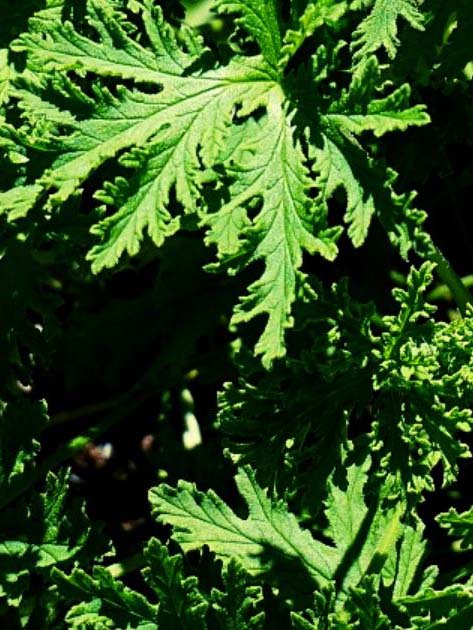
Ants
Depending on the types of ants in the garden, it might not be a problem.
Smaller ants can help with the pollination as they are crawling around the garden, and they can also help to keep caterpillars and other types of pests at bay.
They do not generally cause issues by eating anything in the garden, but if you have a lot of ants, they could always decide to head inside. It might still be a good idea to contact pest control.
Pest Control for Gardens
We have a list of the common garden pests in Singapore. Now let’s discuss some natural ways to protect your garden from pests.
Apply the following solutions to keep most common garden pests away:
- Citronella plants to prevent mosquitoes.
- Avoid overwatering to reduce high levels of dampness, as this attracts many types of pests.
- Dust off the leaves of plants to eliminate potential nesting sites.
- Dish soap mixed with water in a spray bottle can help get rid of many pests that settle on plants.
Pro Tip: Some natural remedies can be ineffective and make pest problems worse, so the best way to get rid of garden pests is to call a professional for help.
What Should You Do?
If you have pests in the garden, the best way to get rid of them is to call a professional for help. They can come and look at your problem, and then determine the best way to proceed and to provide you with a pest free environment.
If you would like more information on how Killem can help you keep your garden pest free, visit our residential pest control services page.

Pest Problem? Let Us Help.
We offer fast and effective precision treatments to eliminate pests while ensuring a safe environment for your home or business.
Frequently Asked Questions
Pests can cause major damage to your garden. They can chew holes in your leaves and feed on roots, which kills the plants.
Sometimes pests are not visible, but you can identify them by the damage in your garden, like holes in leaves, small grubs around the roots of container plants, and skeletonized leaves.
The best way to get rid of the pests is to prevent the infestation in the first place. Check your plants regularly and take measures as soon as you spot the signs of infestation.
Related Posts
How to Carry Out Safe Pest Control with Children and Pets in Your Home
Rodents

Let’s be honest, no one wants to have pests in or near your home, especially when you have children or pets.
Infants and babies may be exposed to more pesticides than adults because they often spend more time closer to the ground, touching furniture bases or playing in the gardens where pesticides may have been applied. Infants and babies are also more likely to put fingers, toys and other objects that may have come into contact with pesticides into their mouths.
There are many different types of pests that can cause serious problems if they get out of hand, and you need to find ways you can control those pests safely and efficiently, without compromising the health and safety of your children and pets.
You can do some basic things that will help to keep the pests out of your home, but there might come a time when you need to call in the professionals.
What Are the Most Common Types of Pests?
While there are many different types of pests that could be plaguing your home, some of the most common and intrusive include:
Pests have the potential to destroy your home, get into your food and carry diseases. You should never have to live with pests. You should find ways to eradicate them.
What Are Safe Pesticides?
When it comes to choosing pesticides that you want, or you want your professional provider to use in and around your home, you need to be very careful. Many brands on the market are full of chemicals that could harm your children and your pets if it were ingested.
When you are choosing pesticides that you can use to deal better with the pests that you find, you should look for those that are organic and that do not have toxic chemicals in them.
One of the best things about working with Killem Pest for your pest control needs is that we use original, non-generic chemicals that are environmentally friendly and have low mammalian toxicity. This means that even if children or pets accidentally ingest the pesticide, they would not become ill.
Pro Tip: To choose an effective pesticide, you need to know what pest you are dealing with.
In addition, you can do other things that will help to keep your children and pets safe. If you are putting out bait for rodents, for example, never leave it in an area where your children or pets could have access to it. They could put it in their mouth. Instead, put the bait into a locked bait station or in an area that cannot be opened or reached by children or pets so that only rodents can access it.
If the pest control company has come and sprayed, make sure that any of the residual spraying has dried before allowing children or pets into the area. Make sure your animals are not licking the plants or the walls where the chemicals were sprayed, too.
You should also always make sure your children wash their hands after they have been playing outdoors, and stress the importance of not touching any bait stations that you might have.
How to Keep Pests Away
The following are some very simple and basic tips that can help you to control some of the pests in and around your home:
- Keeping your food in airtight containers can help to control the influx of ants, as well as rodents and roaches.
- If you have fruit that is left out on the counter, check it regularly to see if there are any bad spots on it, as this can draw fruit flies and other types of pests.
- A natural type of pesticide that you can make at home is citrus oil. You can use equal parts orange peels and water, and simmer them. Remove the peels and put the water into a spray containers and then spray around the windows, doors, and other areas where pests might be getting into the property.

Pest Problem? Let Us Help.
We offer fast and effective precision treatments to eliminate pests while ensuring a safe environment for your home or business.
Call in the Professionals
Of course, when it comes to pest problems, sometimes, the DIY home pest control methods are simply not enough. You need to call in the professionals that can provide you with a thorough service and remove those pests for good no matter what type they might be.
Frequently Asked Questions
The safety depends on the products and quality of services that you use, but generally, products for household insects pose no threat to people or pets. That is of course if the products are applied correctly and at low concentrations.
Modern pest control methods are designed to target pests and remain safe for children and pets in your house. Professionals are trained in safe application techniques and use only safe and approved products.
Although it’s not always necessary, some people feel comfortable taking their children and pets out of the house during pest treatment. Overall, you need to give the products time to dry before letting your household members have free access to the treated areas.



